
AI2BMD
AI-powered ab initio biomolecular dynamics simulation
Stars: 155
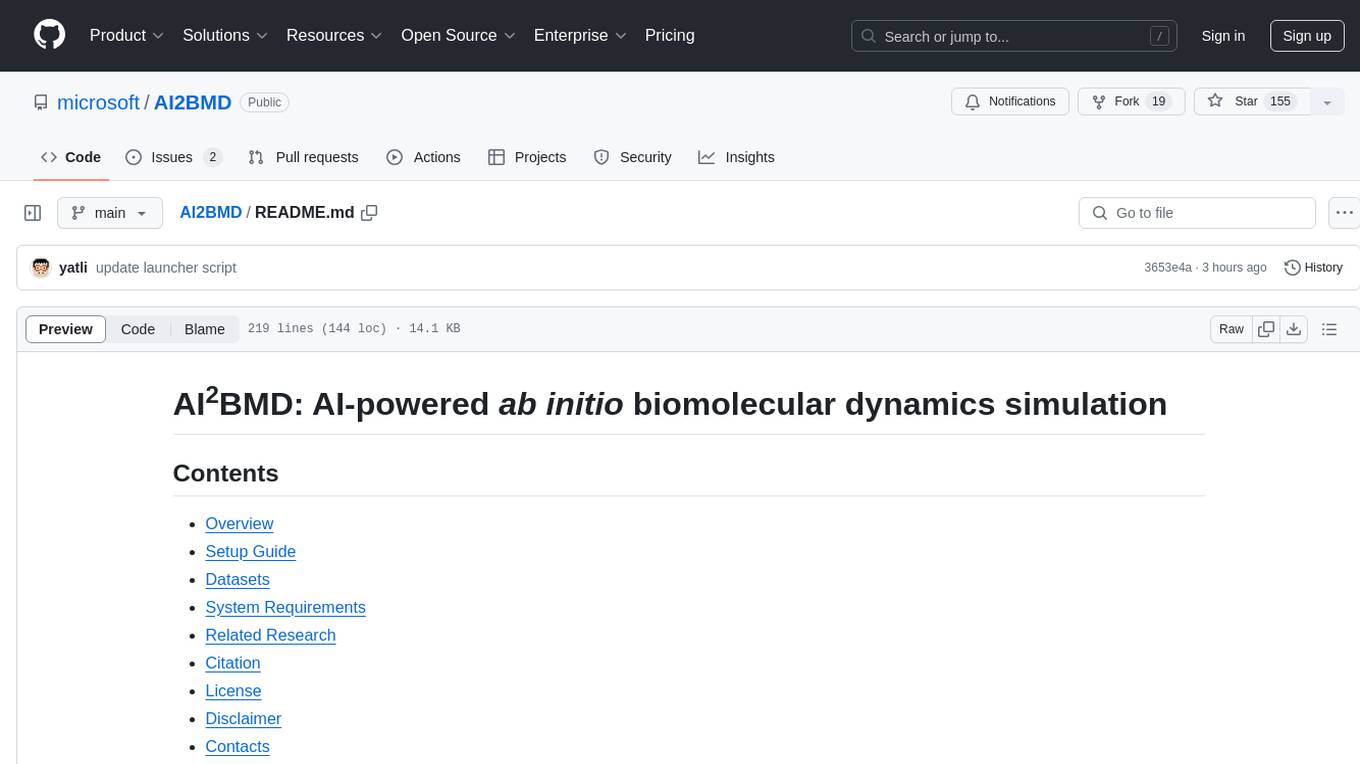
AI2BMD is a program for efficiently simulating protein molecular dynamics with ab initio accuracy. The repository contains datasets, simulation programs, and public materials related to AI2BMD. It provides a Docker image for easy deployment and a standalone launcher program. Users can run simulations by downloading the launcher script and specifying simulation parameters. The repository also includes ready-to-use protein structures for testing. AI2BMD is designed for x86-64 GNU/Linux systems with recommended hardware specifications. The related research includes model architectures like ViSNet, Geoformer, and fine-grained force metrics for MLFF. Citation information and contact details for the AI2BMD Team are provided.
README:
- Overview
- Setup Guide
- Datasets
- System Requirements
- Related Research
- Citation
- License
- Disclaimer
- Contacts
AI2BMD is a program for efficiently simulating protein molecular dynamics with ab initio accuracy. This repository contains datasets, simulation programs, and public materials related to AI2BMD.
The source code of AI2BMD is hosted in this repository.
To streamline the user experience, we package the source code and runtime libraries into a Docker image, and provide a Python launcher program to simplify the deployment process.
To run the simulation program, you don't need to clone this repository. Simply download scripts/ai2bmd and launch it (Python >=3.7 is required).
wget 'https://raw.githubusercontent.com/microsoft/AI2BMD/main/scripts/ai2bmd'
chmod +x ai2bmd
# you may need to "sudo" the following line if the docker group is not configured for the user
./ai2bmd --prot-file path/to/target-protein.pdb --sim-steps nnn ...
# '-------- required argument ---------' '-- optional arguments --'
#
# Notable optional arguments:
#
# [Simulation directory mapping options]
# --base-dir path/to/base-dir A directory for running simulation (defaults to current directory)
# --log-dir path/to/log-dir A directory for saving results (defaults to base-dir/Logs-protein-name)
#
# [Simulation parameter options]
# --sim-steps nnn Simulation steps
# --temp-k nnn Simulation temperature in Kelvin
# --timestep nnn TimeStep (fs) for simulation
# --preeq-steps nnn Pre-equilibration simulation steps for each constraint
# --max-cyc nnn Maximum energy minimization cycles in preprocessing
#
# [Performance tweaks]
# --device-strategy [strategy] The compute device allocation strategy
# small-molecule Bonded/non-bonded/solvent computation share all GPUs, enable GPU oversubscription
# large-molecule No multiple models on the same GPU
# --chunk-size nnn When there's more than device_chunk elements (e.g. dipeptides) in a batch, split them into chunks
# and feed them into GPUs sequentially. Reduces memory consumption
#
# [Additional launcher options]
# --software-update When specified, updates the program in the Docker image before running
# --download-training-data When specified, downloads the AI2BMD training data, and unpacks it in the working directory.
# Ignores all other options.
# --gpus Specifies the GPU devices to passthrough to the program. Can be one of the following:
# all: Passthrough all available GPUs to the program.
# none: Disables GPU passthrough.
# i[,j,k...] Passthrough some GPUs. Example: --gpus 0,1The code repository contains several sample protein structures in the testcases directory. Here we use the Chignolin structure as an example:
# skip the following two lines if you've already set up the launcher
wget 'https://raw.githubusercontent.com/microsoft/AI2BMD/main/scripts/ai2bmd'
chmod +x ai2bmd
# download the Chignolin protein structure data file
wget 'https://raw.githubusercontent.com/microsoft/AI2BMD/main/testcases/chig.pdb'
# launch the program, with all simulation parameters set to default values
# you may need to "sudo" the following line if the docker group is not configured for the user
./ai2bmd --prot-file chig.pdbThe results will be placed in a new directory Logs-chig.
The directory contains the simulation trajectory file:
- chig-traj.traj: The full trajectory file in ASE binary format.
The protein unit dataset covers a wide range of conformations for dipeptides. It can be downloaded with the following commands:
# skip the following two lines if you've already set up the launcher
wget 'https://raw.githubusercontent.com/microsoft/AI2BMD/main/scripts/ai2bmd'
chmod +x ai2bmd
# you may need to "sudo" the following line if the docker group is not configured for the user
./ai2bmd --download-training-dataWhen it finishes, the current working directory will be populated by the numpy data files (*.npz).
The whole comformation MD dataset for proteins calculated at Density Functional Theory (DFT) level. AIMD-Chig consists of 2M conformations of the 166-atom Chignolin and the corresponding potential energy and atomic forces calculated at M06-2X/6-31g* level.
-
Read the article AIMD-Chig: Exploring the conformational space of a 166-atom protein Chignolin with ab initio molecular dynamics.
-
Find the story The first whole conformational molecular dynamics dataset for proteins at ab initio accuracy and the novel computational technologies behind it.
-
Get the dataset AIMD-Chig.
The AI2BMD program runs on x86-64 GNU/Linux systems. We recommend a machine with the following specs:
- CPU: 8+ cores
- Memory: 32+ GB
- GPU: CUDA-enabled GPU with 8+ GB memory
The program has been tested on the following GPUs:
- A100
- V100
- RTX A6000
- Titan RTX
The program has been tested on the following systems:
- OS: Ubuntu 20.04, Docker: 27.1
- OS: ArchLinux, Docker: 26.1
ViSNet (Vector-Scalar interactive graph neural Network) is an equivariant geometry-enhanced graph neural for molecules that significantly alleviates the dilemma between computational costs and the sufficient utilization of geometric information.
-
ViSNet is published on Nature Communications Enhancing geometric representations for molecules with equivariant vector-scalar interactive message passing.
-
ViSNet is selected as "Editors' Highlights" for both "AI and machine learning" and "Biotechnology and methods" fields of Nature Communications.
-
ViSNet has won the Championship in The First Global AI Drug Development Competition and one of the winners in OGB-LSC @ NeurIPS 2022 PCQM4Mv2 Track!
-
Please check out the branch ViSNet for the source code, instructions on model training, and more techniqucal details.
Geoformer (Geometric Transformer) is a novel geometric Transformer to effectively model molecular structures for various molecular property predictions. Geoformer introduces a novel positional encoding method, Interatomic Positional Encoding (IPE), to parameterize atomic environments in Transformer. By incorporating IPE, Geoformer captures valuable geometric information beyond pairwise distances within a Transformer-based architecture. Geoformer can be regarded as a Transformer variant of ViSNet.
- Geoformer was published on NeurIPS 2023.
- Read the paper of Geoformer Geometric Transformer with Interatomic Positional Encoding.
- Please check out the branch Geoformer for the source code, instructions on model training, and more techniqucal details.
Machine learning force fields (MLFFs) have gained popularity in recent years as a cost-effective alternative to ab initio molecular dynamics (MD) simulations. Despite their small errors on test sets, MLFFs inherently suffer from generalization and robustness issues during MD simulations.
To alleviate these issues, we propose the use of global force metrics and fine-grained metrics from elemental and conformational aspects to systematically measure MLFFs for every atom and conformation of molecules. Furthermore, the performance of MLFFs and the stability of MD simulations can be enhanced by employing the proposed force metrics during model training. This includes training MLFF models using these force metrics as loss functions, fine-tuning by reweighting samples in the original dataset, and continued training by incorporating additional unexplored data.
- Read the Cover Story article Improving machine learning force fields for molecular dynamics simulations with fine-grained force metrics .
Markov state models (MSMs) play a key role in studying protein conformational dynamics. A sliding count window with a fixed lag time is commonly used to sample sub-trajectories for transition counting and MSM construction. However, sub-trajectories sampled with a fixed lag time may not perform well under different selections of lag time, requiring strong prior experience and resulting in less robust estimations.
To alleviate this, we propose a novel stochastic method based on a Poisson process to generate perturbative lag times for sub-trajectory sampling and use it to construct a Markov chain. Comprehensive evaluations on the double-well system, WW domain, BPTI, and RBD–ACE2 complex of SARS-CoV-2 reveal that our algorithm significantly increases the robustness and accuracy of the constructed MSM without disrupting its Markovian properties. Furthermore, the advantages of our algorithm are especially pronounced for slow dynamic modes in complex biological processes.
-
Read the Cover Story article Stochastic Lag Time Parameterization for Markov State Models of Protein Dynamics.
-
Find an application case in studying the Spike-ACE2 complex structure for the highly infectious mechanism of Omicron: Structural insights into the SARS-CoV-2 Omicron RBD-ACE2 interaction.
(#: co-first author; *: corresponding author)
Yusong Wang#, Tong Wang#*, Shaoning Li#, Xinheng He, Mingyu Li, Zun Wang, Nanning Zheng, Bin Shao*, Tie-Yan Liu, Enhancing geometric representations for molecules with equivariant vector-scalar interactive message passing, Nature Communications, 15.1 (2024): 313.
Yusong Wang#, Shaoning Li#, Tong Wang*, Bin Shao, Nanning Zheng, Tie-Yan Liu. Geometric Transformer with Interatomic Positional Encoding. NeurIPS 2023.
Zun Wang#, Hongfei Wu#, Lixin Sun, Xinheng He, Zhirong Liu, Bin Shao, Tong Wang*, Tie-Yan Liu. Improving machine learning force fields for molecular dynamics simulations with fine-grained force metrics, The Journal of Chemical Physics, Volume 159, Issue 3, Cover Story.
Tong Wang#*, Xinheng He#, Mingyu Li#, Bin Shao*, Tie-Yan Liu. AIMD-Chig: Exploring the conformational space of a 166-atom protein Chignolin with ab initio molecular dynamics, Scientific Data 10, 549 (2023).
Shiqi Gong#, Xinheng He#, Qi Meng, Zhiming Ma, Bin Shao*, Tong Wang*, Tie-Yan Liu. Stochastic Lag Time Parameterization for Markov State Models of Protein Dynamics, The Journal of Physical Chemistry B 2022 126 (46), Cover Story, 2022.
Copyright (c) Microsoft Corporation. All rights reserved.
Licensed under the MIT license.
AI2BMD is a research project. It is not an officially supported Microsoft product.
Please contact AI2BMD Team for any questions or suggestions. The main team members include:
- Tong Wang (Primary lead/contact)
- Yatao Li
- Ran Bi
- Bin Shao
- Tie-Yan Liu
For Tasks:
Click tags to check more tools for each tasksFor Jobs:
Alternative AI tools for AI2BMD
Similar Open Source Tools

AI2BMD
AI2BMD is a program for efficiently simulating protein molecular dynamics with ab initio accuracy. The repository contains datasets, simulation programs, and public materials related to AI2BMD. It provides a Docker image for easy deployment and a standalone launcher program. Users can run simulations by downloading the launcher script and specifying simulation parameters. The repository also includes ready-to-use protein structures for testing. AI2BMD is designed for x86-64 GNU/Linux systems with recommended hardware specifications. The related research includes model architectures like ViSNet, Geoformer, and fine-grained force metrics for MLFF. Citation information and contact details for the AI2BMD Team are provided.
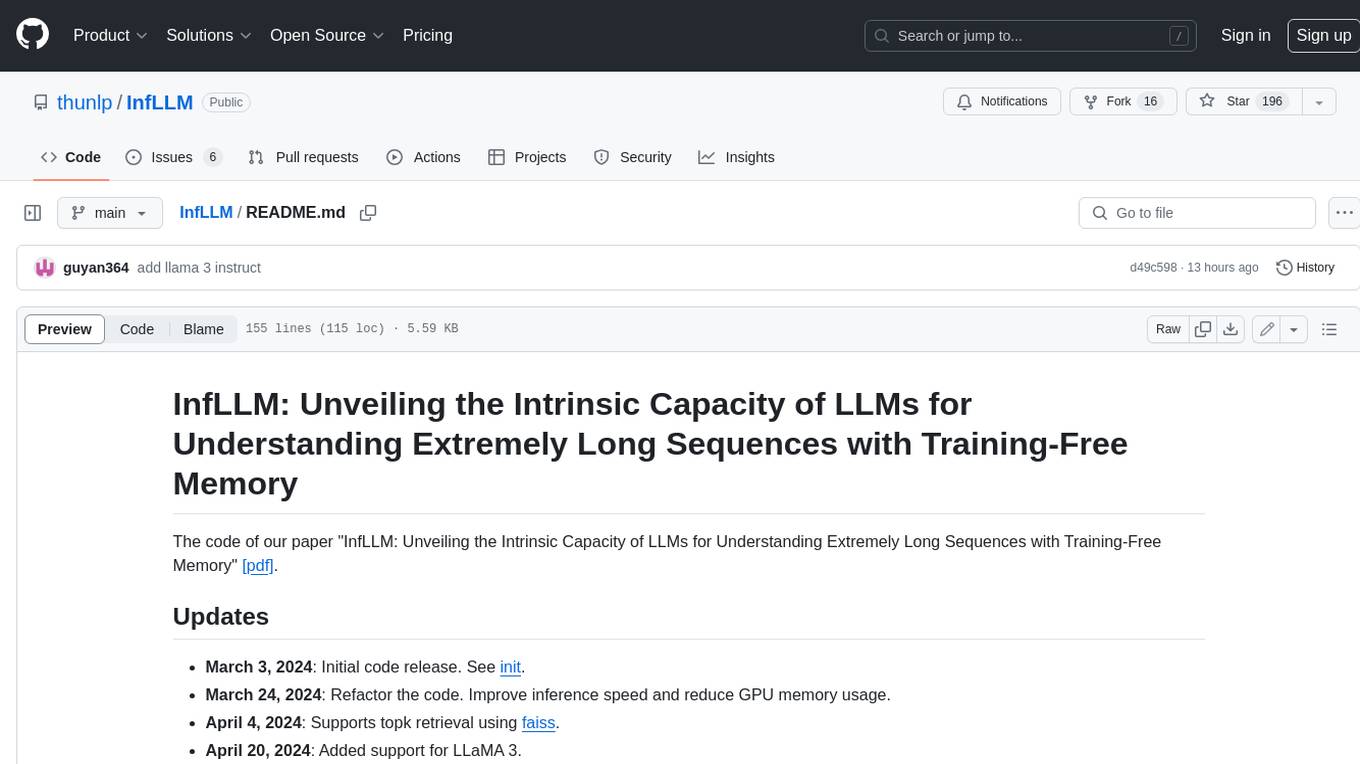
InfLLM
InfLLM is a training-free memory-based method that unveils the intrinsic ability of LLMs to process streaming long sequences. It stores distant contexts into additional memory units and employs an efficient mechanism to lookup token-relevant units for attention computation. Thereby, InfLLM allows LLMs to efficiently process long sequences while maintaining the ability to capture long-distance dependencies. Without any training, InfLLM enables LLMs pre-trained on sequences of a few thousand tokens to achieve superior performance than competitive baselines continually training these LLMs on long sequences. Even when the sequence length is scaled to 1, 024K, InfLLM still effectively captures long-distance dependencies.
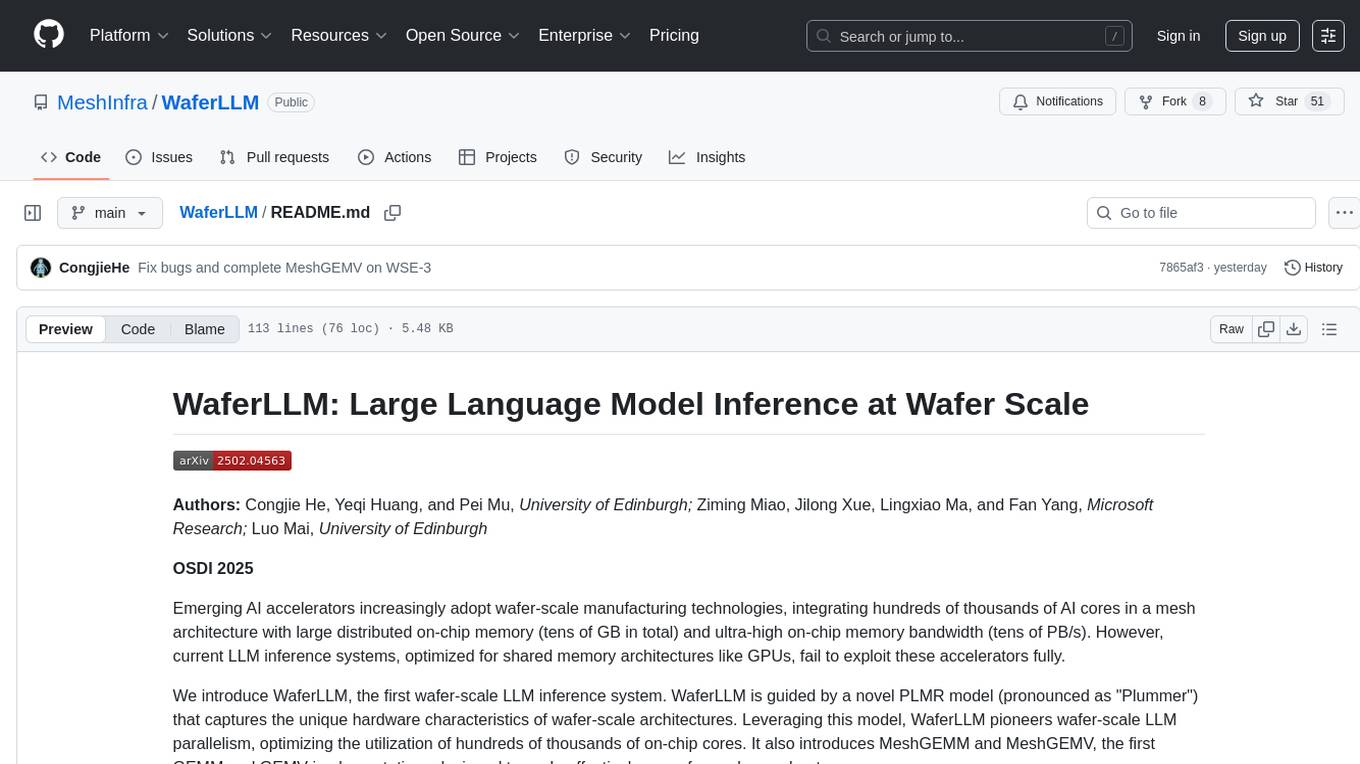
WaferLLM
WaferLLM is the first wafer-scale Large Language Model (LLM) inference system designed to optimize the utilization of hundreds of thousands of on-chip cores in wafer-scale accelerators. It introduces MeshGEMM and MeshGEMV implementations for effective scaling on wafer-scale architectures, achieving significantly higher accelerator utilization and speedups compared to state-of-the-art methods. Users need the Cerebras SDK to reproduce the results, and the project provides detailed documentation and scripts for running simulations on both simulator and actual hardware.
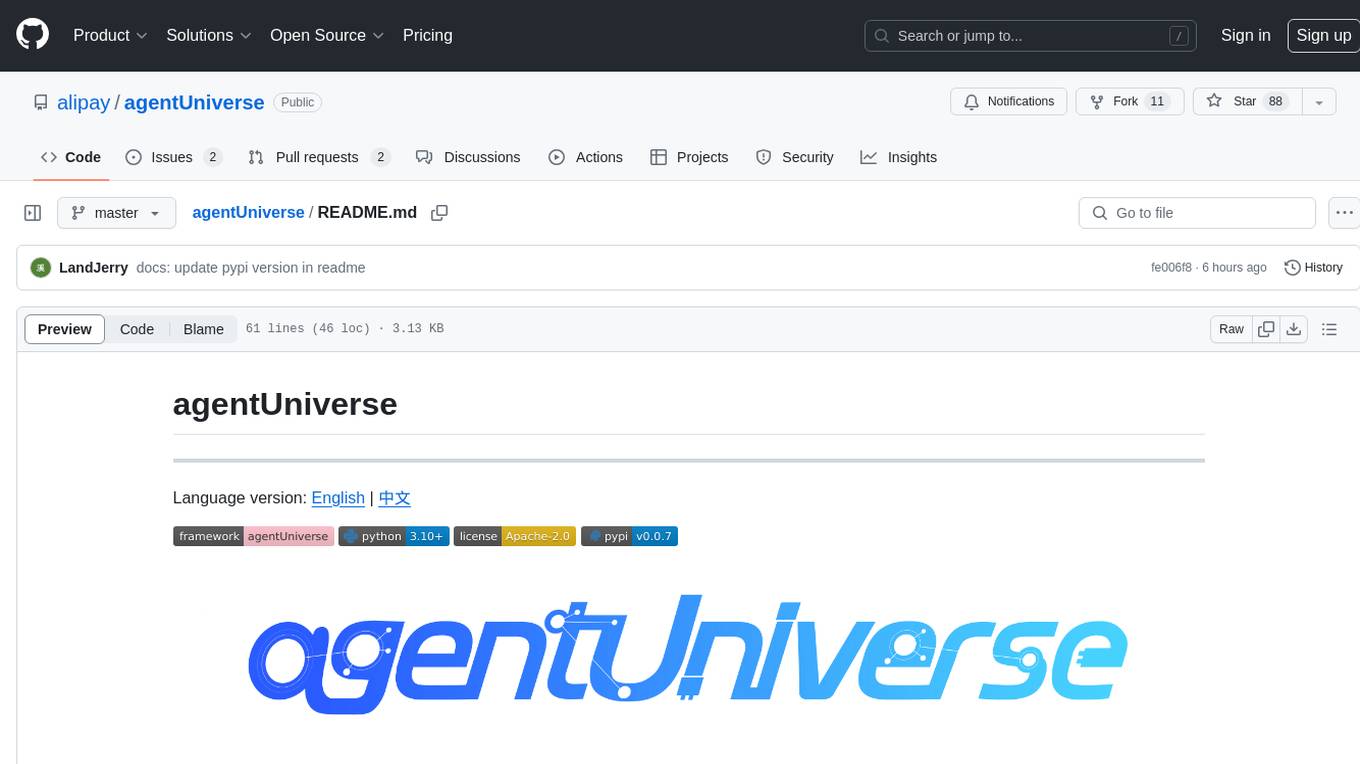
agentUniverse
agentUniverse is a framework for developing applications powered by multi-agent based on large language model. It provides essential components for building single agent and multi-agent collaboration mechanism for customizing collaboration patterns. Developers can easily construct multi-agent applications and share pattern practices from different fields. The framework includes pre-installed collaboration patterns like PEER and DOE for complex task breakdown and data-intensive tasks.
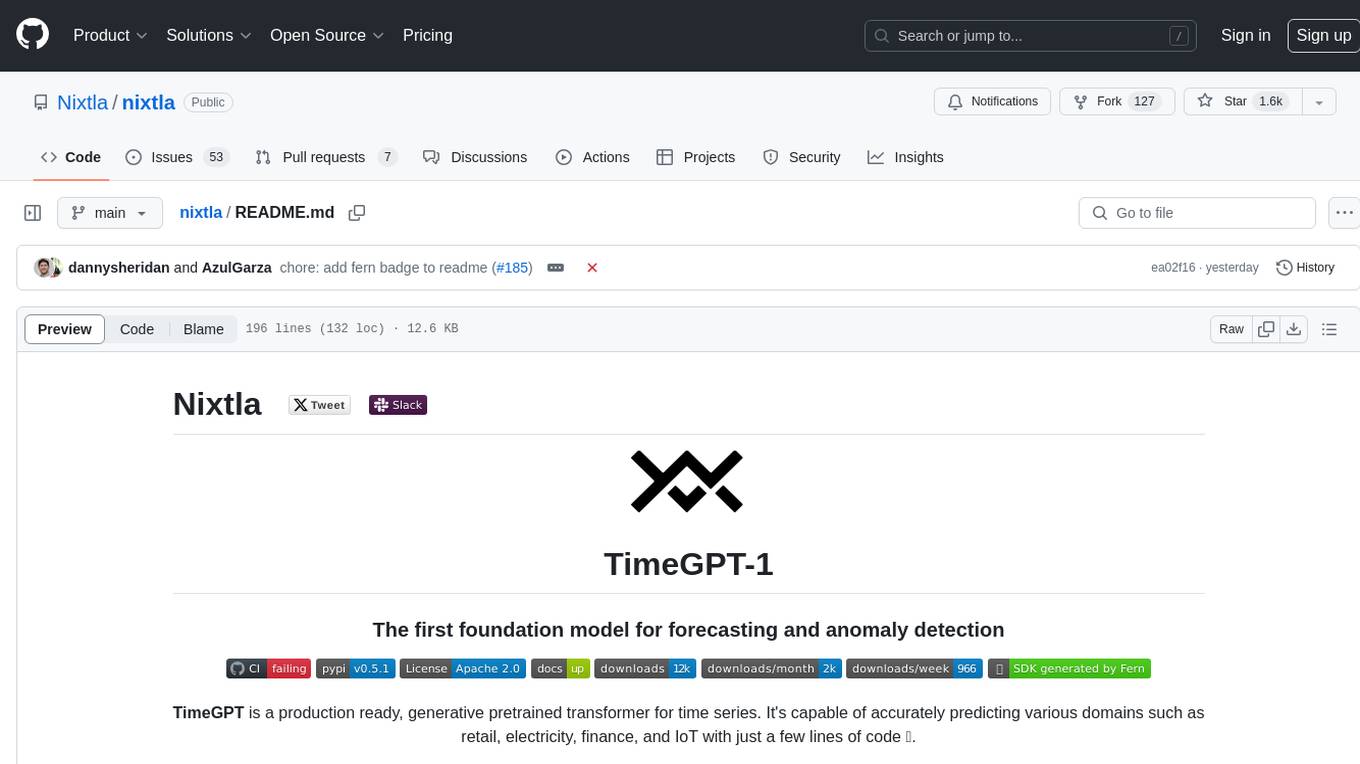
nixtla
Nixtla is a production-ready generative pretrained transformer for time series forecasting and anomaly detection. It can accurately predict various domains such as retail, electricity, finance, and IoT with just a few lines of code. TimeGPT introduces a paradigm shift with its standout performance, efficiency, and simplicity, making it accessible even to users with minimal coding experience. The model is based on self-attention and is independently trained on a vast time series dataset to minimize forecasting error. It offers features like zero-shot inference, fine-tuning, API access, adding exogenous variables, multiple series forecasting, custom loss function, cross-validation, prediction intervals, and handling irregular timestamps.
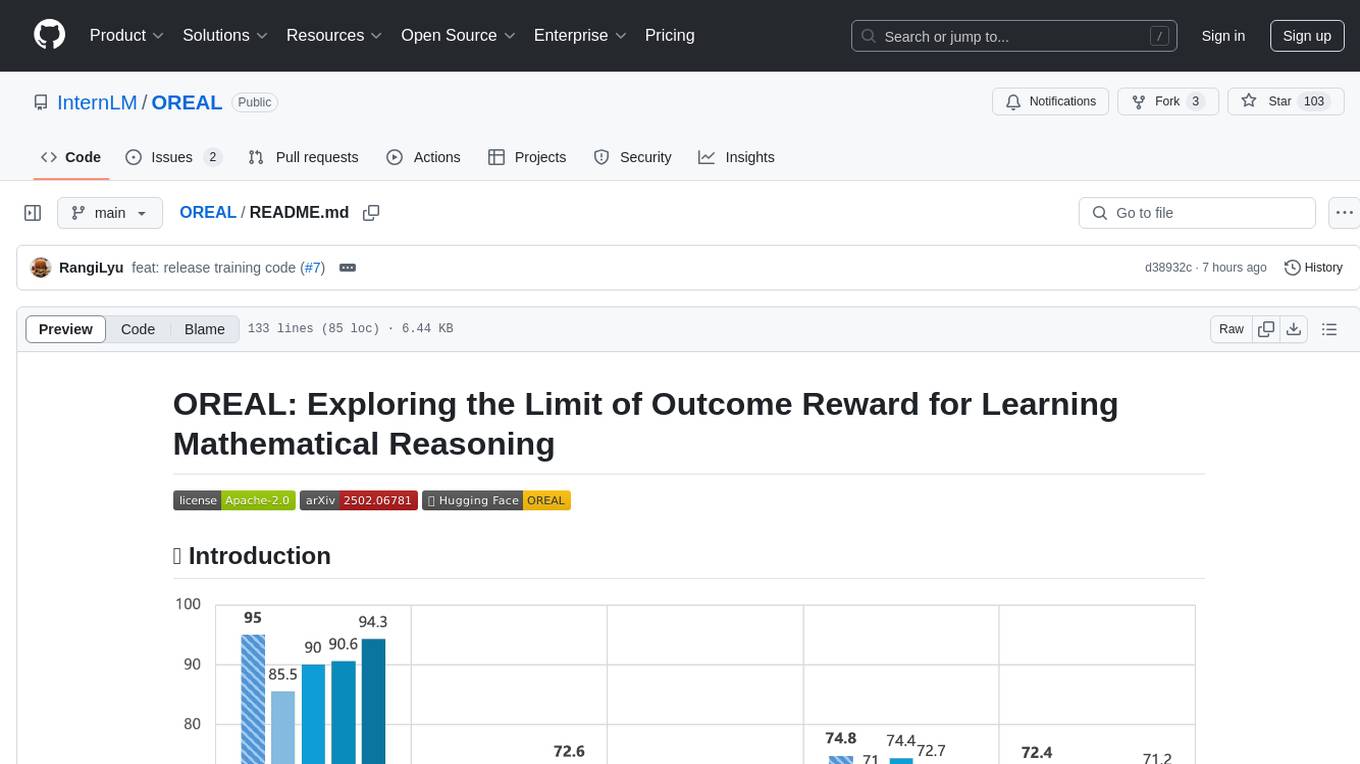
OREAL
OREAL is a reinforcement learning framework designed for mathematical reasoning tasks, aiming to achieve optimal performance through outcome reward-based learning. The framework utilizes behavior cloning, reshaping rewards, and token-level reward models to address challenges in sparse rewards and partial correctness. OREAL has achieved significant results, with a 7B model reaching 94.0 pass@1 accuracy on MATH-500 and surpassing previous 32B models. The tool provides training tutorials and Hugging Face model repositories for easy access and implementation.
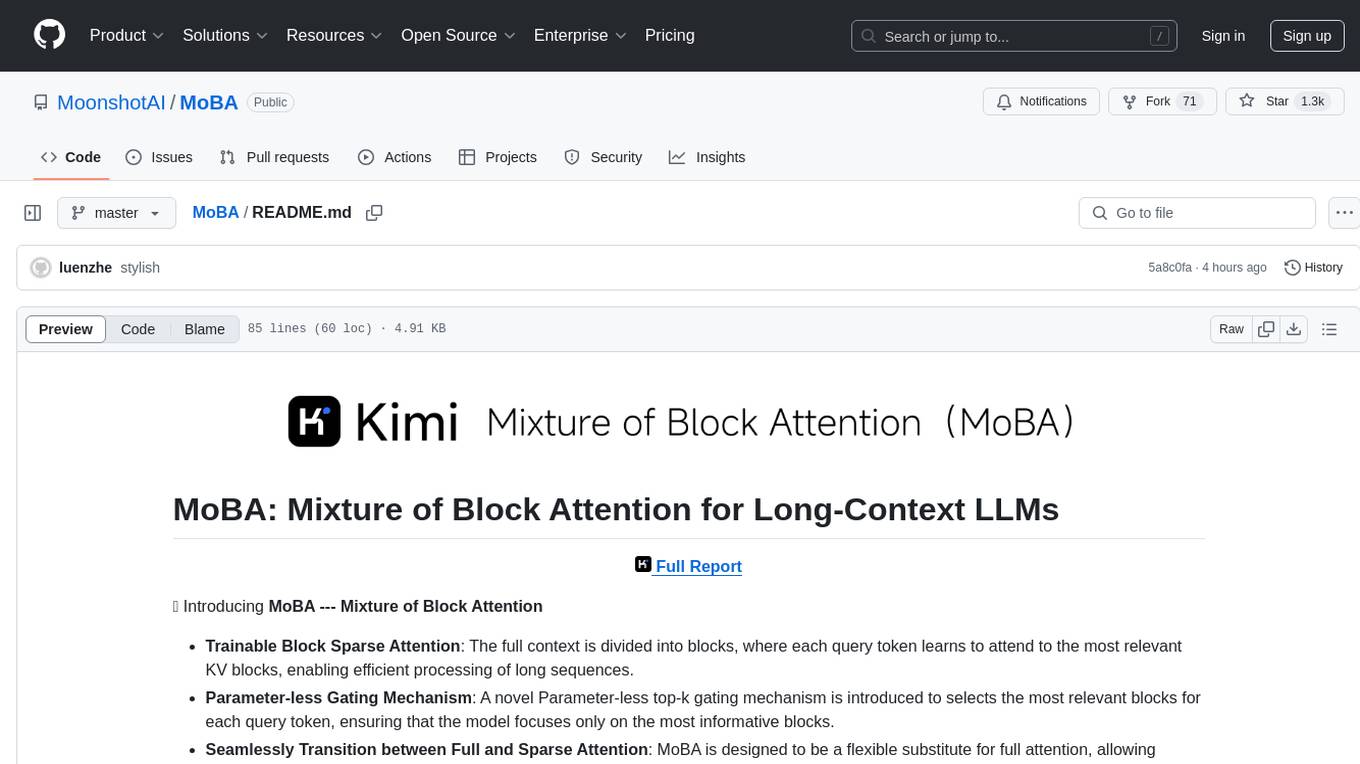
MoBA
MoBA (Mixture of Block Attention) is an innovative approach for long-context language models, enabling efficient processing of long sequences by dividing the full context into blocks and introducing a parameter-less gating mechanism. It allows seamless transitions between full and sparse attention modes, enhancing efficiency without compromising performance. MoBA has been deployed to support long-context requests and demonstrates significant advancements in efficient attention computation for large language models.
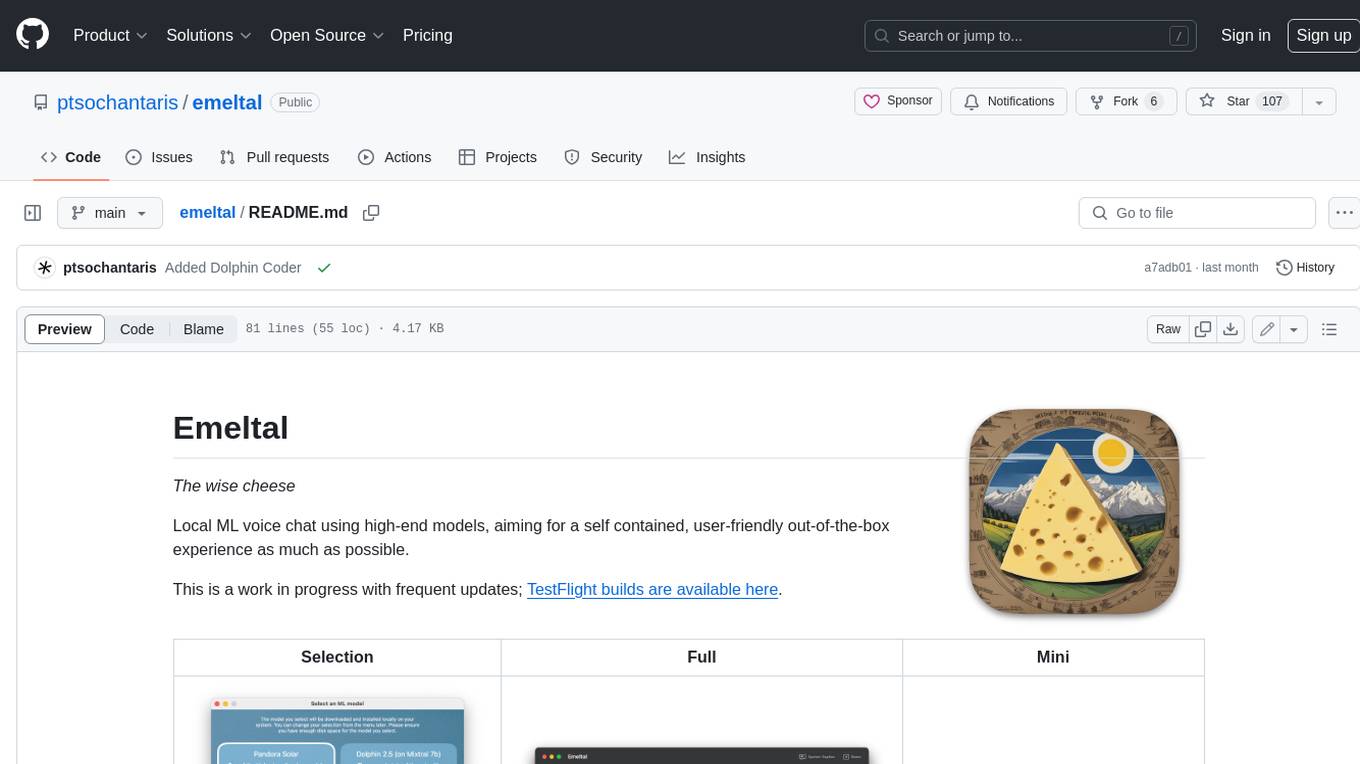
emeltal
Emeltal is a local ML voice chat tool that uses high-end models to provide a self-contained, user-friendly out-of-the-box experience. It offers a hand-picked list of proven open-source high-performance models, aiming to provide the best model for each category/size combination. Emeltal heavily relies on the llama.cpp for LLM processing, and whisper.cpp for voice recognition. Text rendering uses Ink to convert between Markdown and HTML. It uses PopTimer for debouncing things. Emeltal is released under the terms of the MIT license, and all model data which is downloaded locally by the app comes from HuggingFace, and use of the models and data is subject to the respective license of each specific model.
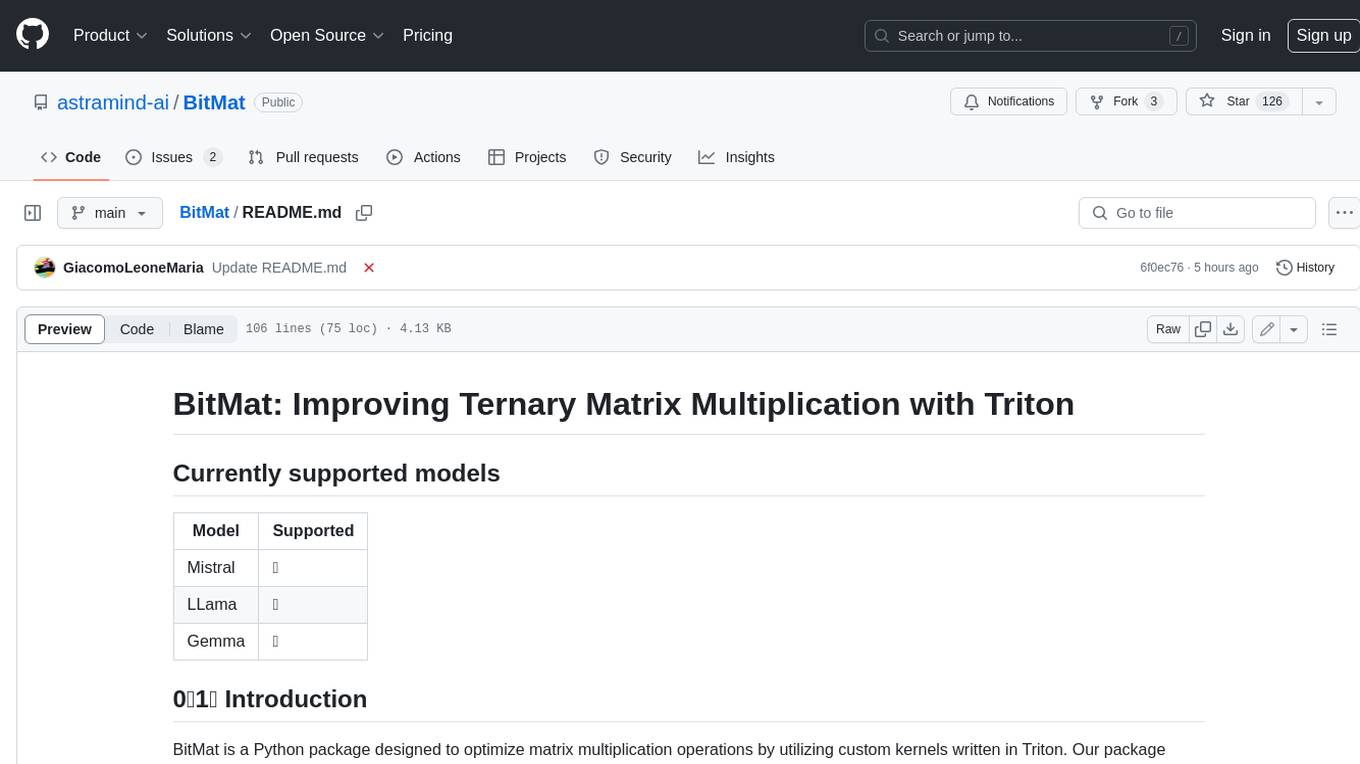
BitMat
BitMat is a Python package designed to optimize matrix multiplication operations by utilizing custom kernels written in Triton. It leverages the principles outlined in the "1bit-LLM Era" paper, specifically utilizing packed int8 data to enhance computational efficiency and performance in deep learning and numerical computing tasks.
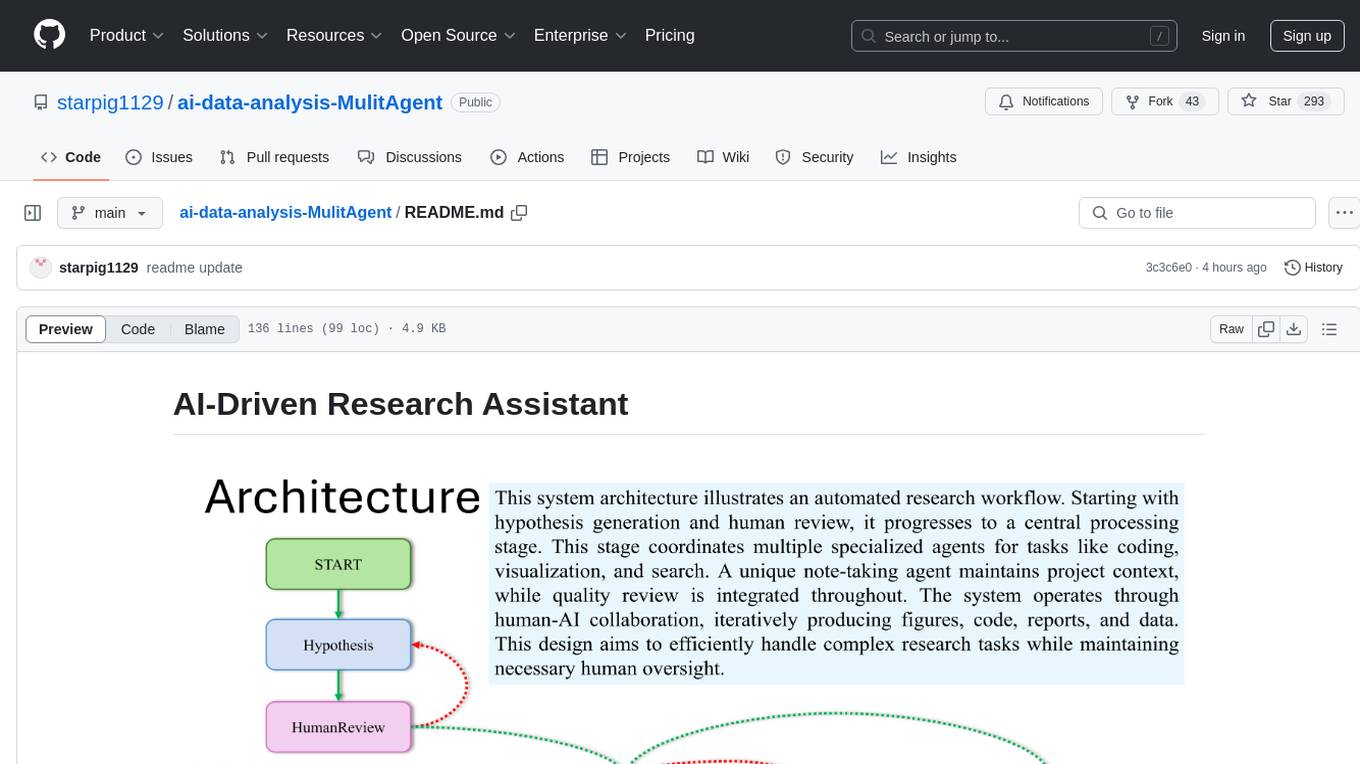
ai-data-analysis-MulitAgent
AI-Driven Research Assistant is an advanced AI-powered system utilizing specialized agents for data analysis, visualization, and report generation. It integrates LangChain, OpenAI's GPT models, and LangGraph for complex research processes. Key features include hypothesis generation, data processing, web search, code generation, and report writing. The system's unique Note Taker agent maintains project state, reducing overhead and improving context retention. System requirements include Python 3.10+ and Jupyter Notebook environment. Installation involves cloning the repository, setting up a Conda virtual environment, installing dependencies, and configuring environment variables. Usage instructions include setting data, running Jupyter Notebook, customizing research tasks, and viewing results. Main components include agents for hypothesis generation, process supervision, visualization, code writing, search, report writing, quality review, and note-taking. Workflow involves hypothesis generation, processing, quality review, and revision. Customization is possible by modifying agent creation and workflow definition. Current issues include OpenAI errors, NoteTaker efficiency, runtime optimization, and refiner improvement. Contributions via pull requests are welcome under the MIT License.
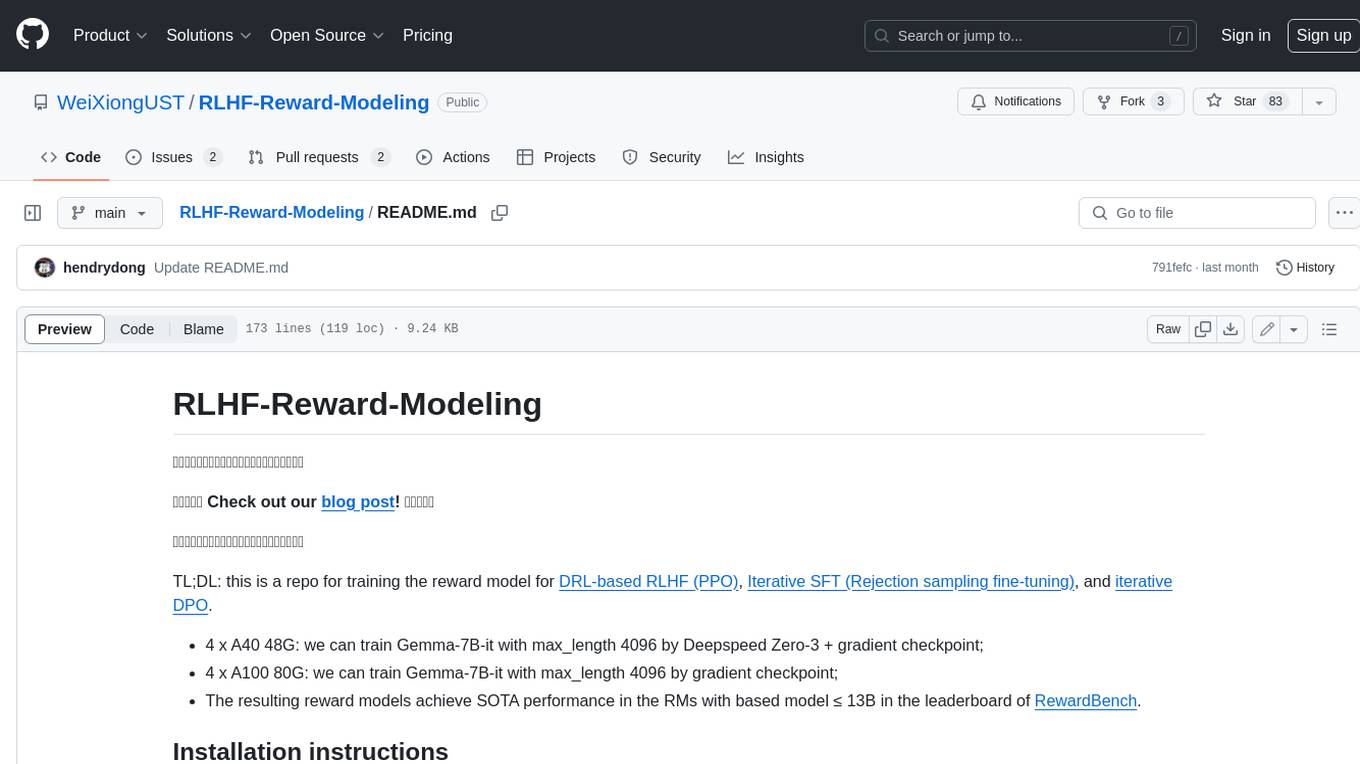
RLHF-Reward-Modeling
This repository contains code for training reward models for Deep Reinforcement Learning-based Reward-modulated Hierarchical Fine-tuning (DRL-based RLHF), Iterative Selection Fine-tuning (Rejection sampling fine-tuning), and iterative Decision Policy Optimization (DPO). The reward models are trained using a Bradley-Terry model based on the Gemma and Mistral language models. The resulting reward models achieve state-of-the-art performance on the RewardBench leaderboard for reward models with base models of up to 13B parameters.
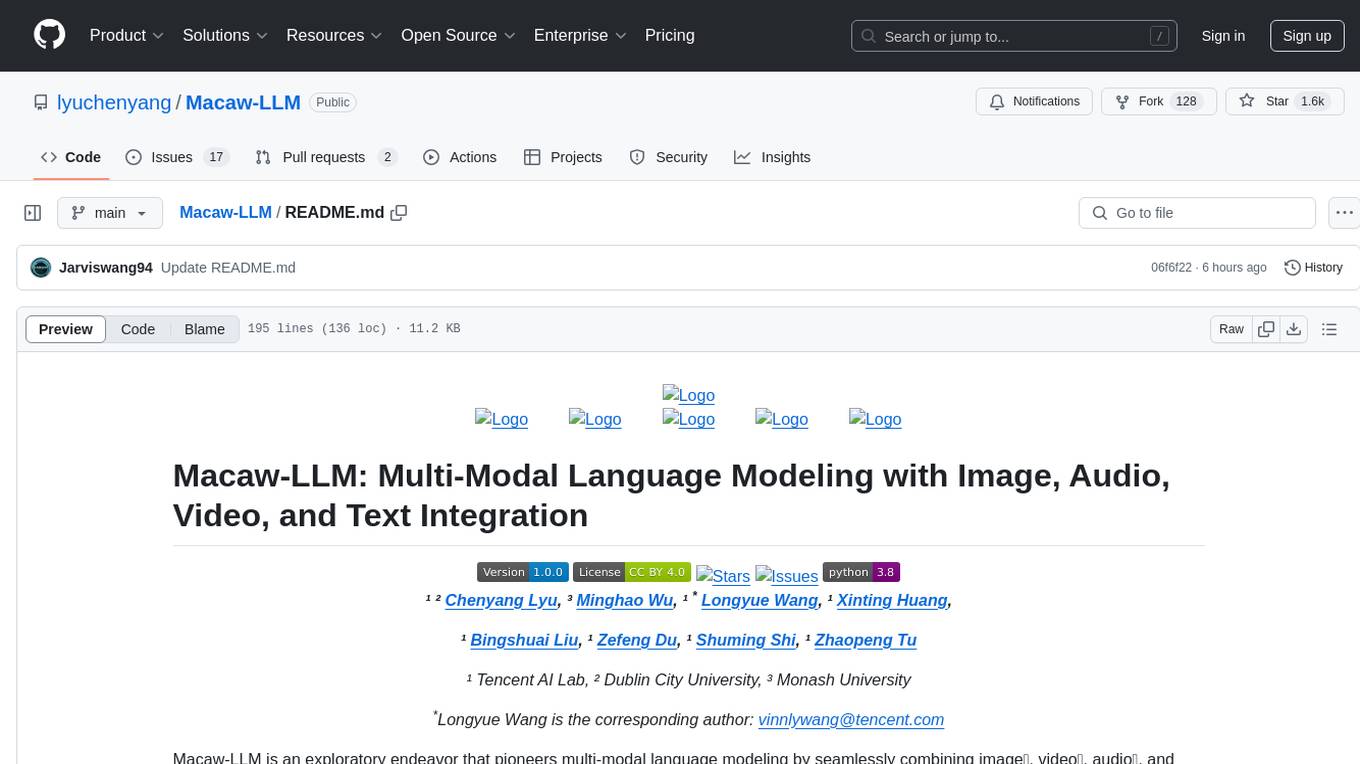
Macaw-LLM
Macaw-LLM is a pioneering multi-modal language modeling tool that seamlessly integrates image, audio, video, and text data. It builds upon CLIP, Whisper, and LLaMA models to process and analyze multi-modal information effectively. The tool boasts features like simple and fast alignment, one-stage instruction fine-tuning, and a new multi-modal instruction dataset. It enables users to align multi-modal features efficiently, encode instructions, and generate responses across different data types.
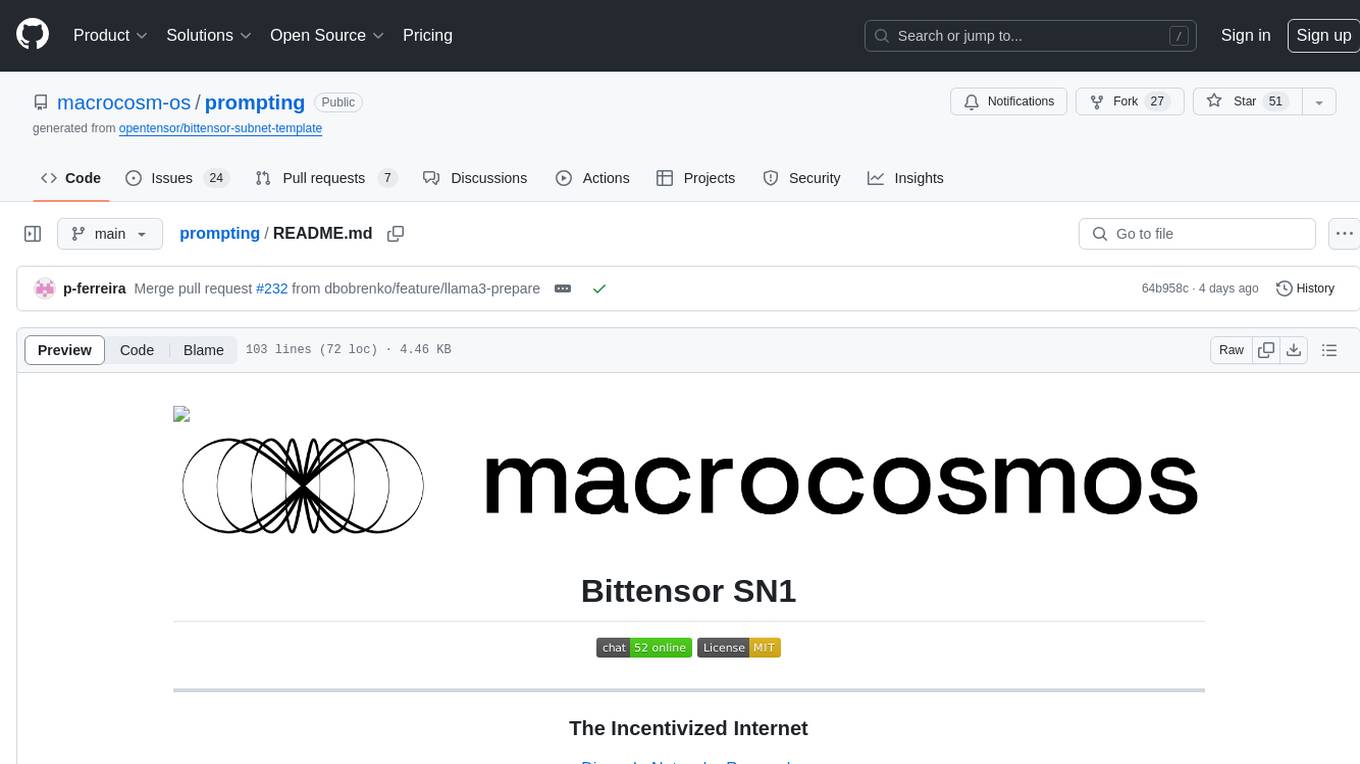
prompting
This repository contains the official codebase for Bittensor Subnet 1 (SN1) v1.0.0+, released on 22nd January 2024. It defines an incentive mechanism to create a distributed conversational AI for Subnet 1. Validators and miners are based on large language models (LLM) using internet-scale datasets and goal-driven behavior to drive human-like conversations. The repository requires python3.9 or higher and provides compute requirements for running validators and miners. Users can run miners or validators using specific commands and are encouraged to run on the testnet before deploying on the main network. The repository also highlights limitations and provides resources for understanding the architecture and methodology of SN1.
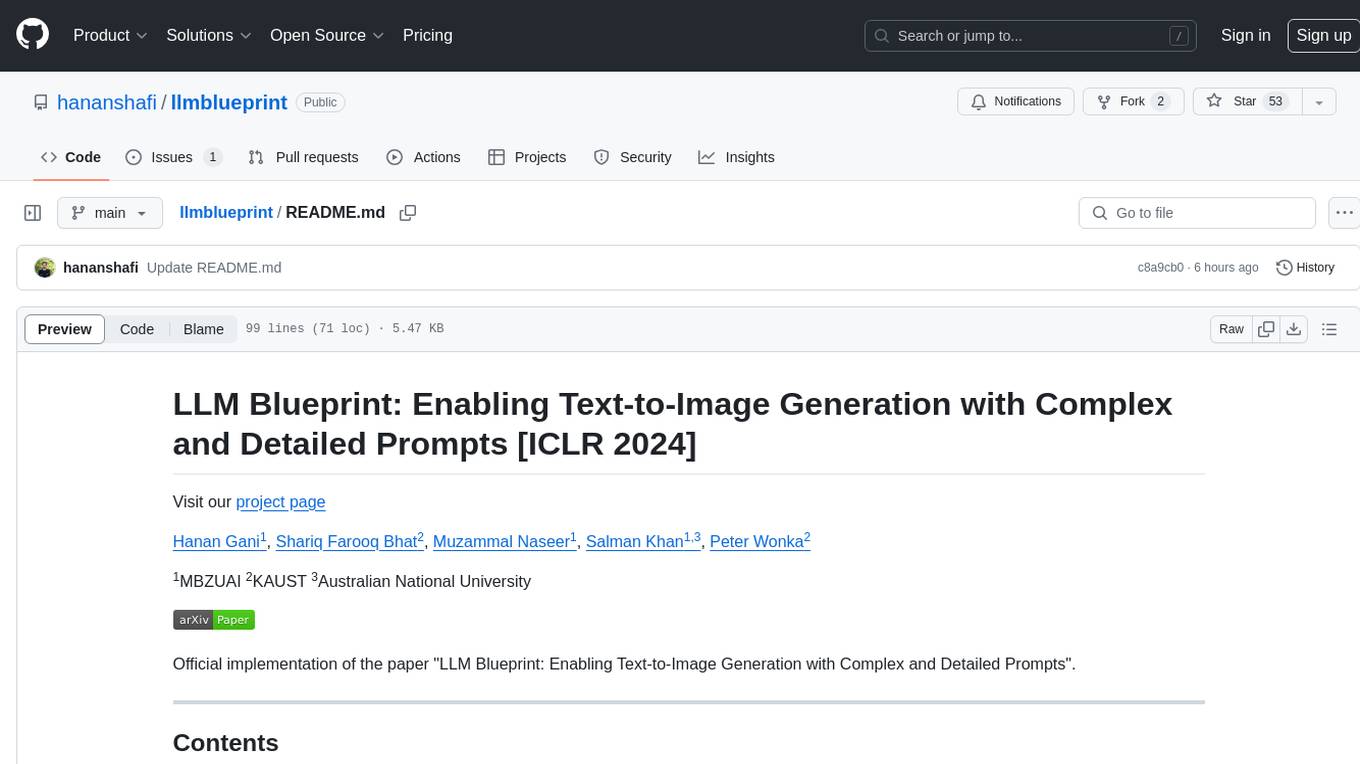
llmblueprint
LLM Blueprint is an official implementation of a paper that enables text-to-image generation with complex and detailed prompts. It leverages Large Language Models (LLMs) to extract critical components from text prompts, including bounding box coordinates for foreground objects, detailed textual descriptions for individual objects, and a succinct background context. The tool operates in two phases: Global Scene Generation creates an initial scene using object layouts and background context, and an Iterative Refinement Scheme refines box-level content to align with textual descriptions, ensuring consistency and improving recall compared to baseline diffusion models.
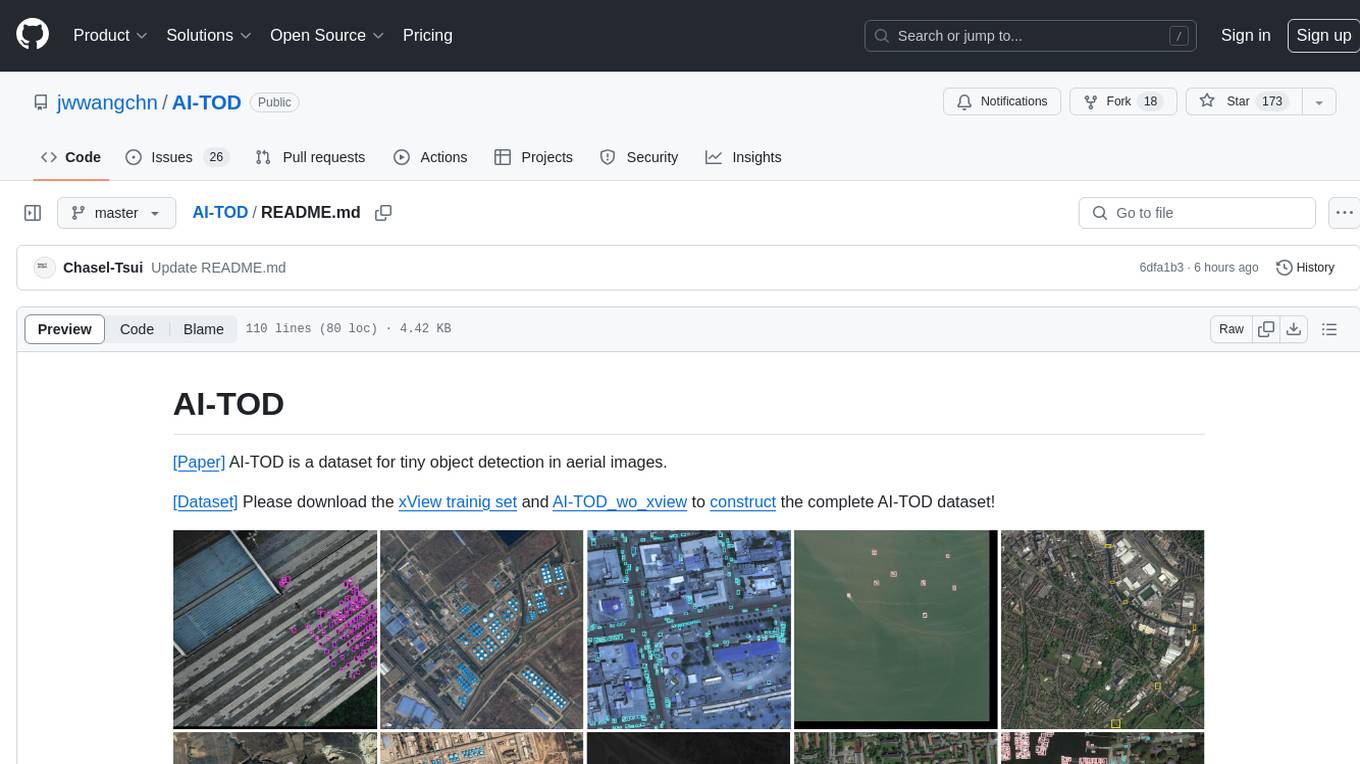
AI-TOD
AI-TOD is a dataset for tiny object detection in aerial images, containing 700,621 object instances across 28,036 images. Objects in AI-TOD are smaller with a mean size of 12.8 pixels compared to other aerial image datasets. To use AI-TOD, download xView training set and AI-TOD_wo_xview, then generate the complete dataset using the provided synthesis tool. The dataset is publicly available for academic and research purposes under CC BY-NC-SA 4.0 license.
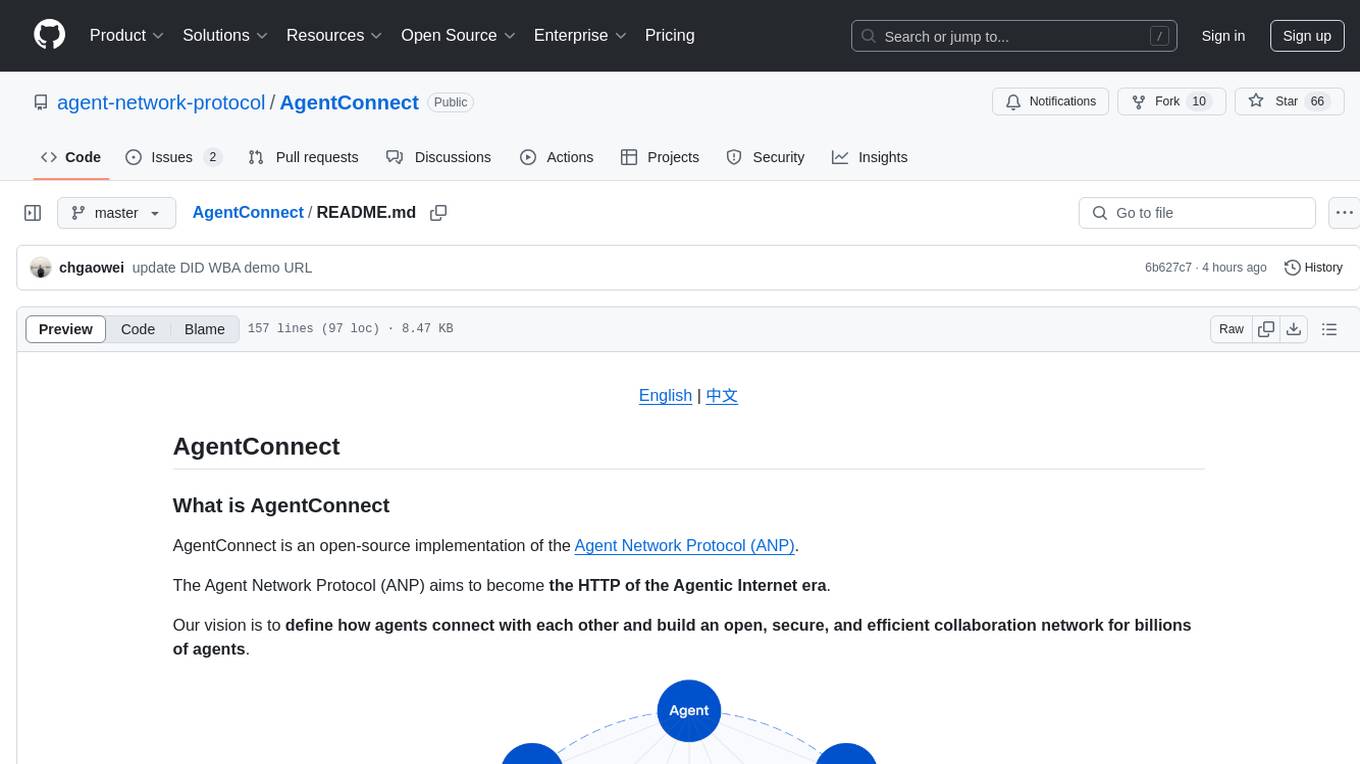
AgentConnect
AgentConnect is an open-source implementation of the Agent Network Protocol (ANP) aiming to define how agents connect with each other and build an open, secure, and efficient collaboration network for billions of agents. It addresses challenges like interconnectivity, native interfaces, and efficient collaboration by providing authentication, end-to-end encryption, meta-protocol handling, and application layer protocol integration. The project focuses on performance and multi-platform support, with plans to rewrite core components in Rust and support Mac, Linux, Windows, mobile platforms, and browsers. AgentConnect aims to establish ANP as an industry standard through protocol development and forming a standardization committee.
For similar tasks

AI2BMD
AI2BMD is a program for efficiently simulating protein molecular dynamics with ab initio accuracy. The repository contains datasets, simulation programs, and public materials related to AI2BMD. It provides a Docker image for easy deployment and a standalone launcher program. Users can run simulations by downloading the launcher script and specifying simulation parameters. The repository also includes ready-to-use protein structures for testing. AI2BMD is designed for x86-64 GNU/Linux systems with recommended hardware specifications. The related research includes model architectures like ViSNet, Geoformer, and fine-grained force metrics for MLFF. Citation information and contact details for the AI2BMD Team are provided.
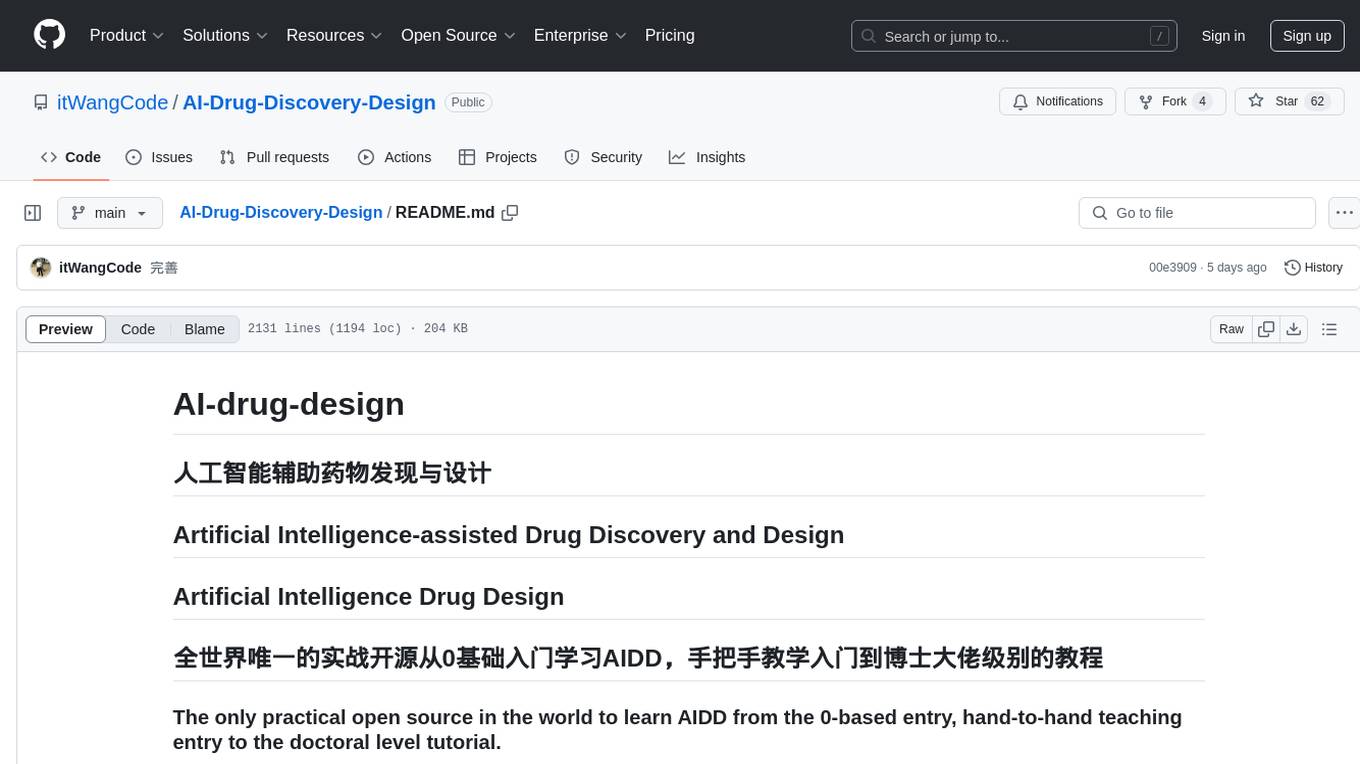
AI-Drug-Discovery-Design
AI-Drug-Discovery-Design is a repository focused on Artificial Intelligence-assisted Drug Discovery and Design. It explores the use of AI technology to accelerate and optimize the drug development process. The advantages of AI in drug design include speeding up research cycles, improving accuracy through data-driven models, reducing costs by minimizing experimental redundancies, and enabling personalized drug design for specific patients or disease characteristics.
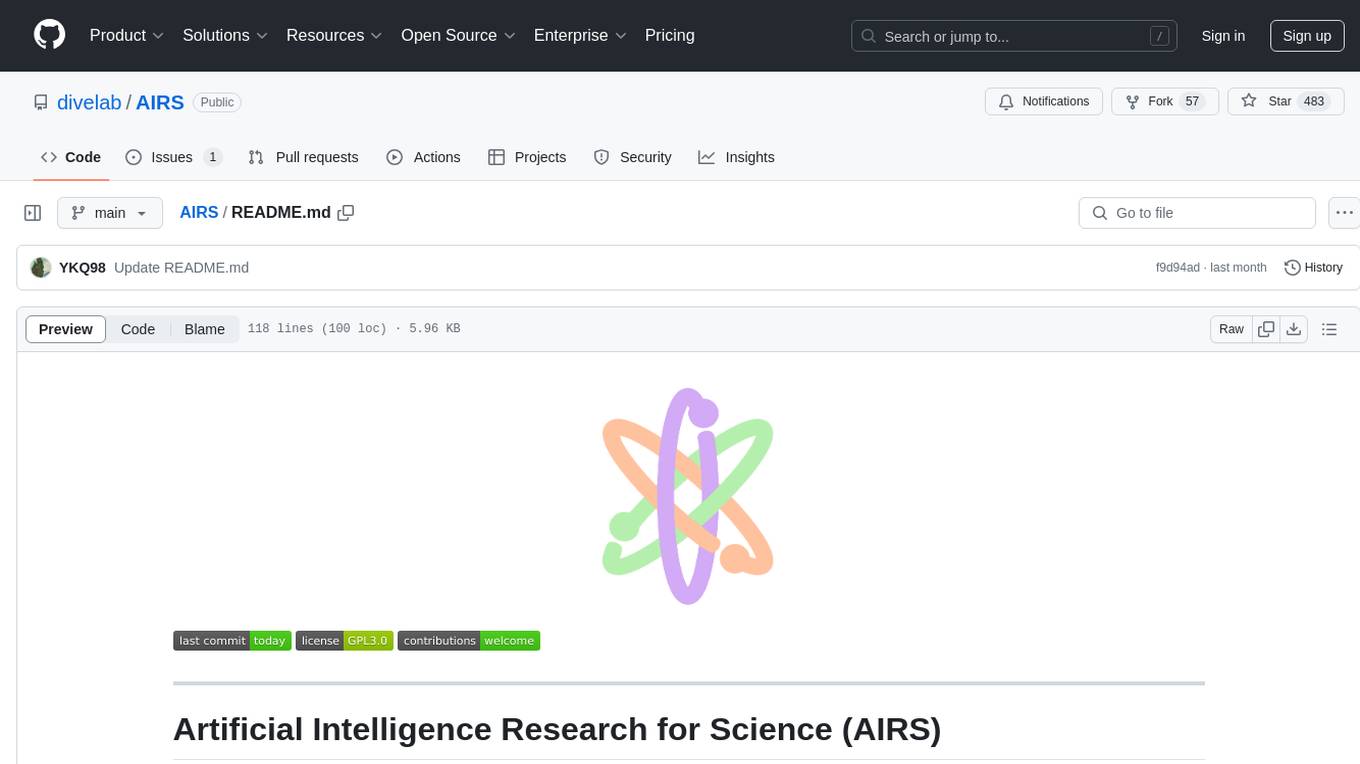
AIRS
AIRS is a collection of open-source software tools, datasets, and benchmarks focused on Artificial Intelligence for Science in Quantum, Atomistic, and Continuum Systems. The goal is to develop and maintain an integrated, open, reproducible, and sustainable set of resources to advance the field of AI for Science. The current resources include tools for Quantum Mechanics, Density Functional Theory, Small Molecules, Protein Science, Materials Science, Molecular Interactions, and Partial Differential Equations.

Magick
Magick is a groundbreaking visual AIDE (Artificial Intelligence Development Environment) for no-code data pipelines and multimodal agents. Magick can connect to other services and comes with nodes and templates well-suited for intelligent agents, chatbots, complex reasoning systems and realistic characters.
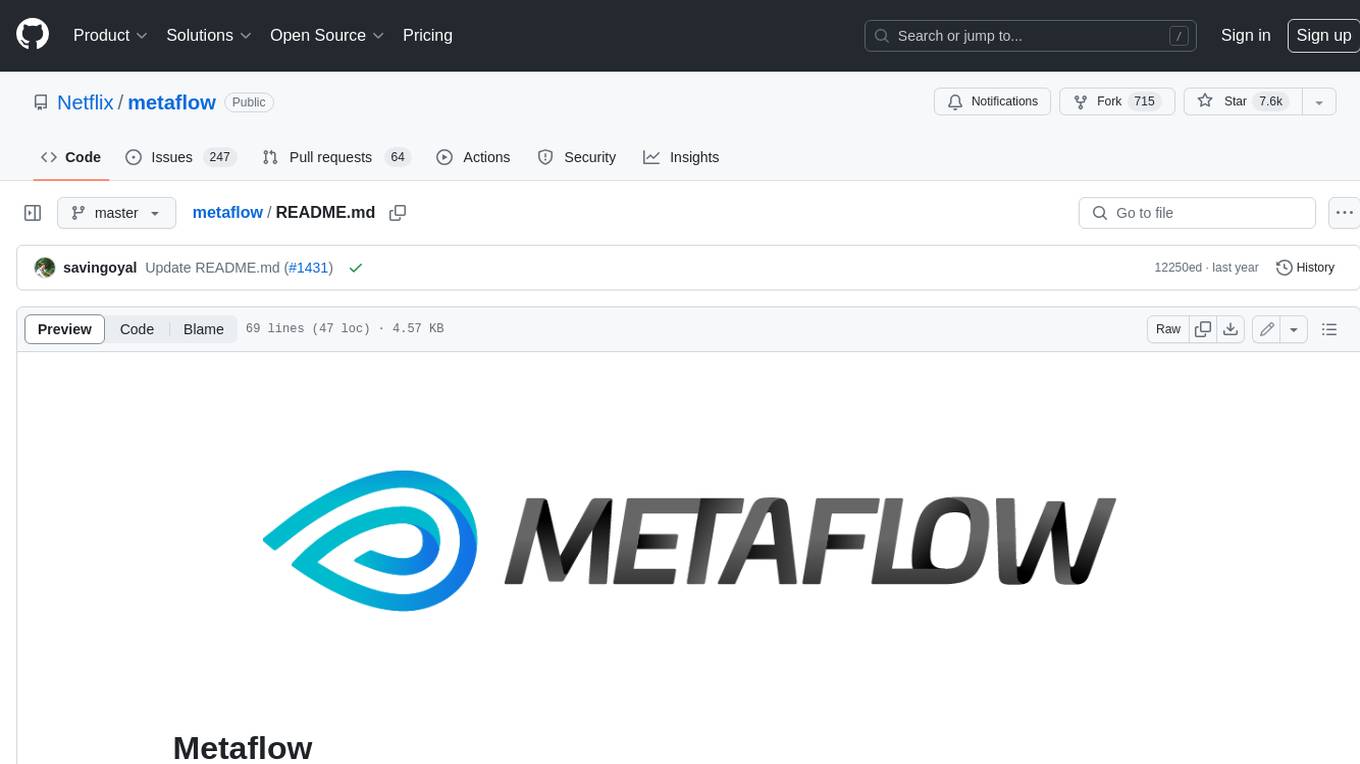
metaflow
Metaflow is a user-friendly library designed to assist scientists and engineers in developing and managing real-world data science projects. Initially created at Netflix, Metaflow aimed to enhance the productivity of data scientists working on diverse projects ranging from traditional statistics to cutting-edge deep learning. For further information, refer to Metaflow's website and documentation.
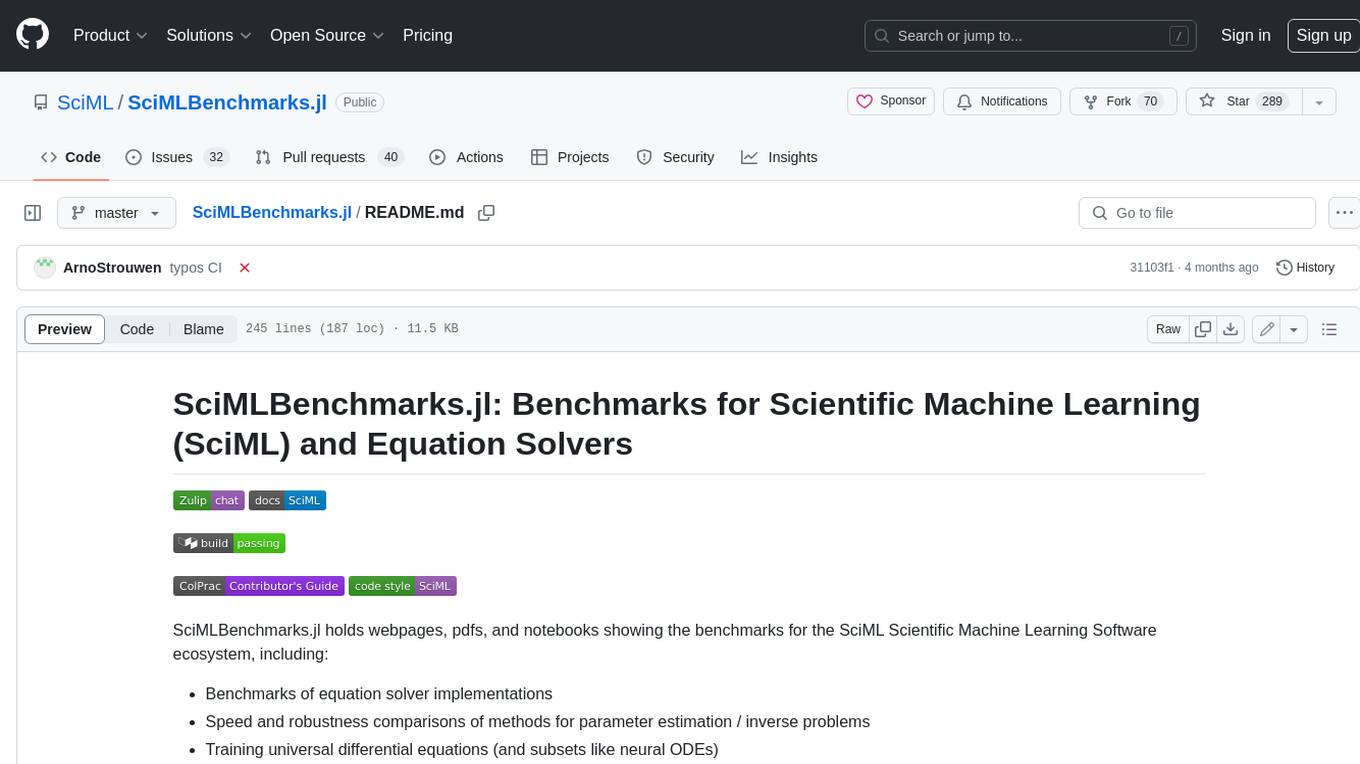
SciMLBenchmarks.jl
SciMLBenchmarks.jl holds webpages, pdfs, and notebooks showing the benchmarks for the SciML Scientific Machine Learning Software ecosystem, including: * Benchmarks of equation solver implementations * Speed and robustness comparisons of methods for parameter estimation / inverse problems * Training universal differential equations (and subsets like neural ODEs) * Training of physics-informed neural networks (PINNs) * Surrogate comparisons, including radial basis functions, neural operators (DeepONets, Fourier Neural Operators), and more The SciML Bench suite is made to be a comprehensive open source benchmark from the ground up, covering the methods of computational science and scientific computing all the way to AI for science.
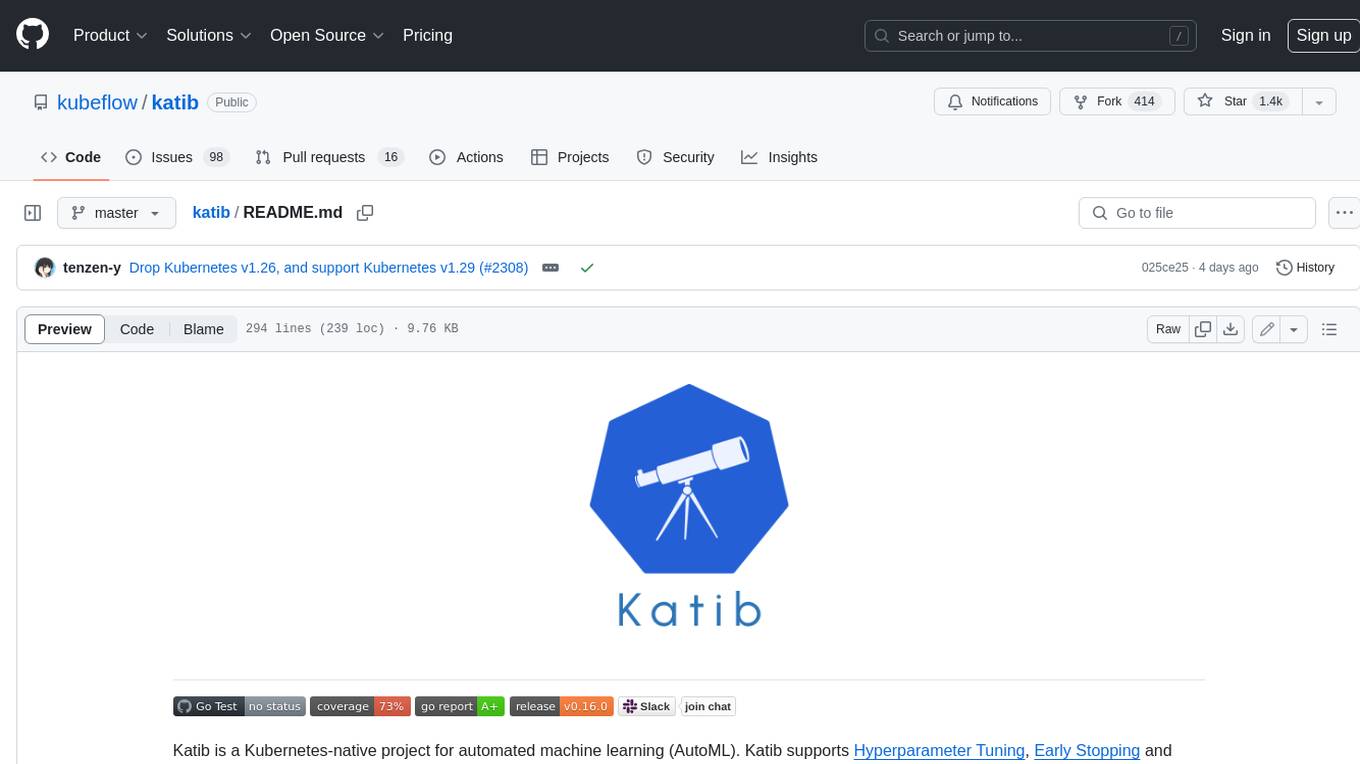
katib
Katib is a Kubernetes-native project for automated machine learning (AutoML). Katib supports Hyperparameter Tuning, Early Stopping and Neural Architecture Search. Katib is the project which is agnostic to machine learning (ML) frameworks. It can tune hyperparameters of applications written in any language of the users’ choice and natively supports many ML frameworks, such as TensorFlow, Apache MXNet, PyTorch, XGBoost, and others. Katib can perform training jobs using any Kubernetes Custom Resources with out of the box support for Kubeflow Training Operator, Argo Workflows, Tekton Pipelines and many more.
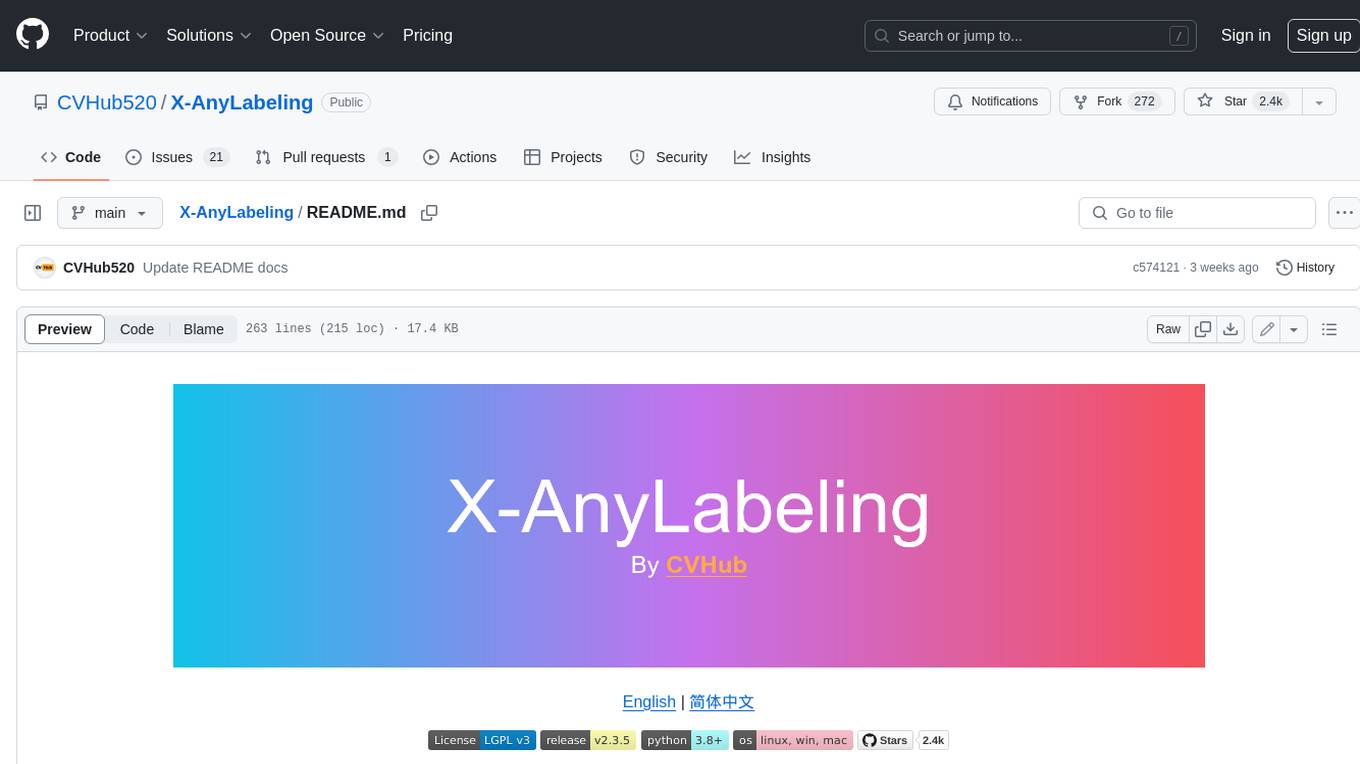
X-AnyLabeling
X-AnyLabeling is a robust annotation tool that seamlessly incorporates an AI inference engine alongside an array of sophisticated features. Tailored for practical applications, it is committed to delivering comprehensive, industrial-grade solutions for image data engineers. This tool excels in swiftly and automatically executing annotations across diverse and intricate tasks.
For similar jobs
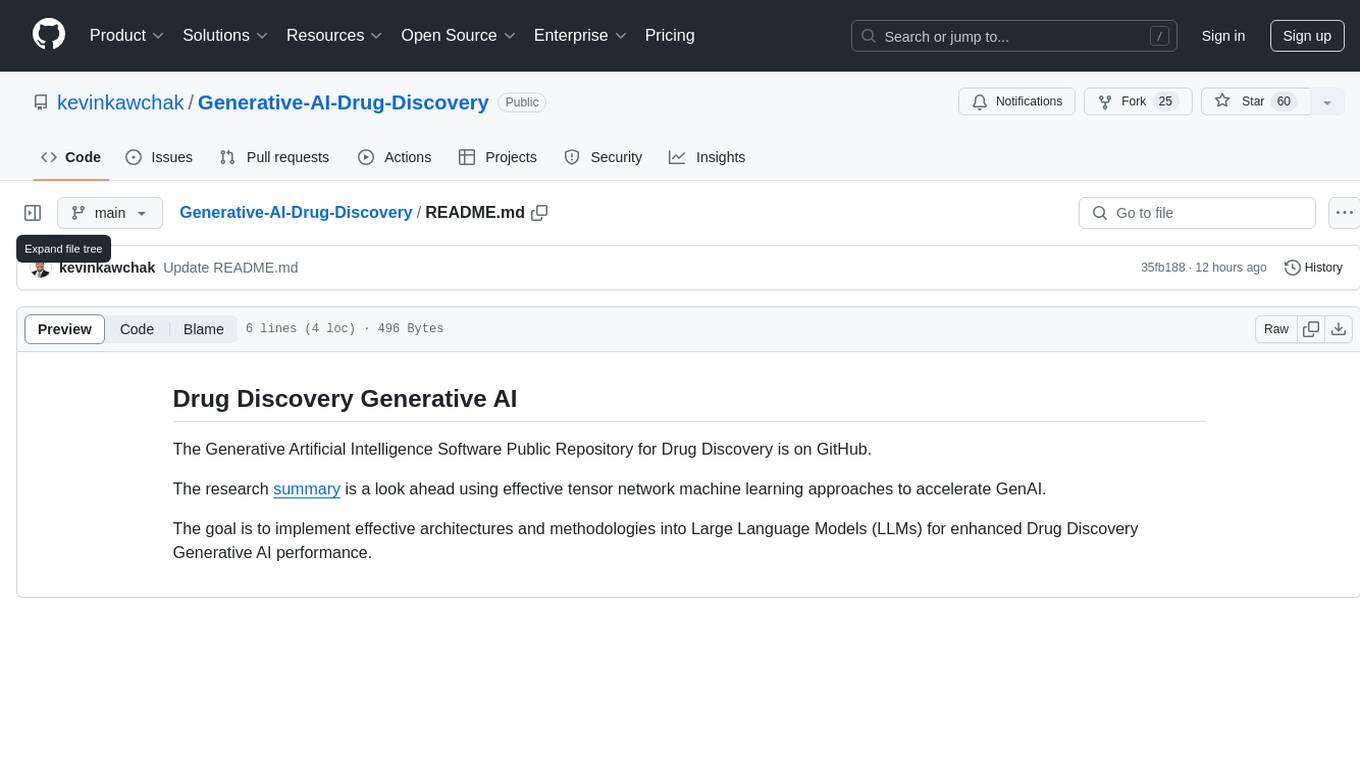
Generative-AI-Drug-Discovery
Generative-AI-Drug-Discovery is a public repository on GitHub focused on using tensor network machine learning approaches to accelerate GenAI for drug discovery. The repository aims to implement effective architectures and methodologies into Large Language Models (LLMs) to enhance Drug Discovery Generative AI performance.

AI2BMD
AI2BMD is a program for efficiently simulating protein molecular dynamics with ab initio accuracy. The repository contains datasets, simulation programs, and public materials related to AI2BMD. It provides a Docker image for easy deployment and a standalone launcher program. Users can run simulations by downloading the launcher script and specifying simulation parameters. The repository also includes ready-to-use protein structures for testing. AI2BMD is designed for x86-64 GNU/Linux systems with recommended hardware specifications. The related research includes model architectures like ViSNet, Geoformer, and fine-grained force metrics for MLFF. Citation information and contact details for the AI2BMD Team are provided.
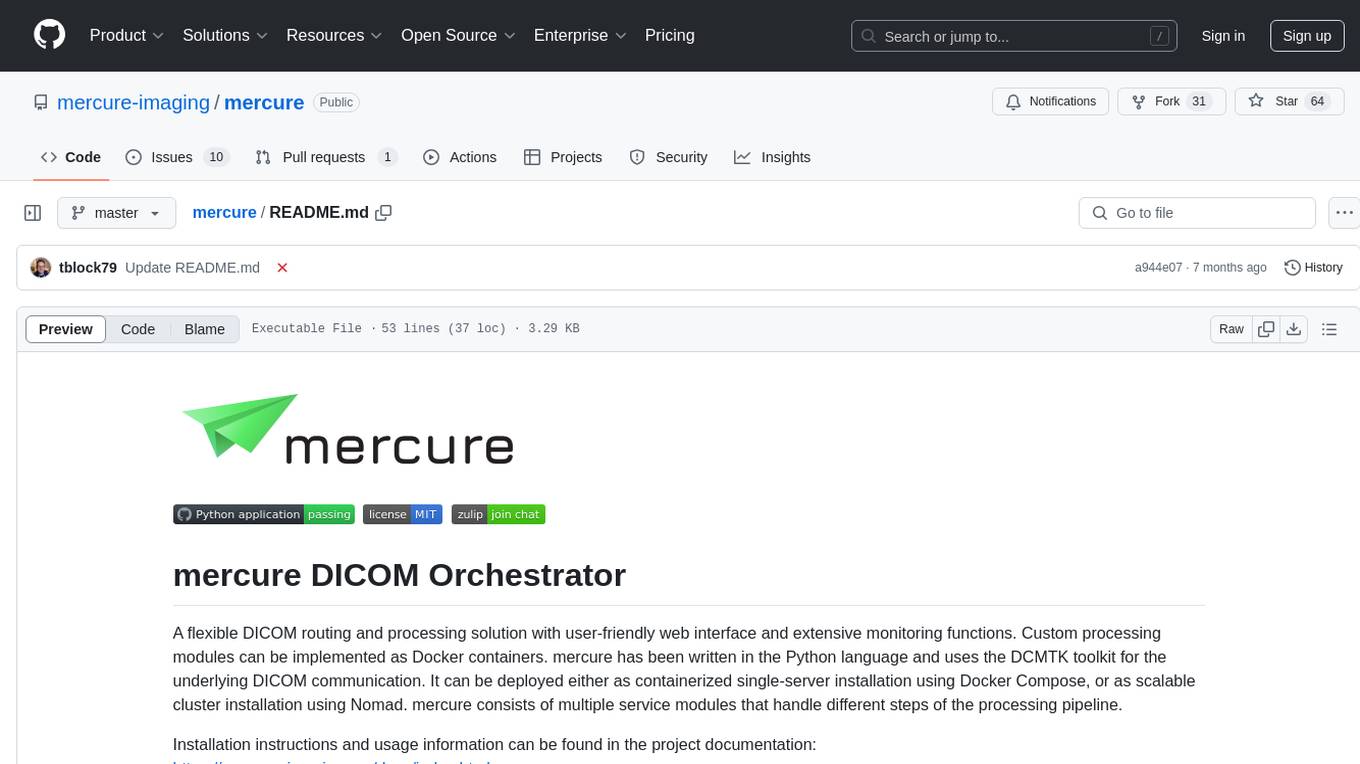
mercure
mercure DICOM Orchestrator is a flexible solution for routing and processing DICOM files. It offers a user-friendly web interface and extensive monitoring functions. Custom processing modules can be implemented as Docker containers. Written in Python, it uses the DCMTK toolkit for DICOM communication. It can be deployed as a single-server installation using Docker Compose or as a scalable cluster installation using Nomad. mercure consists of service modules for receiving, routing, processing, dispatching, cleaning, web interface, and central monitoring.
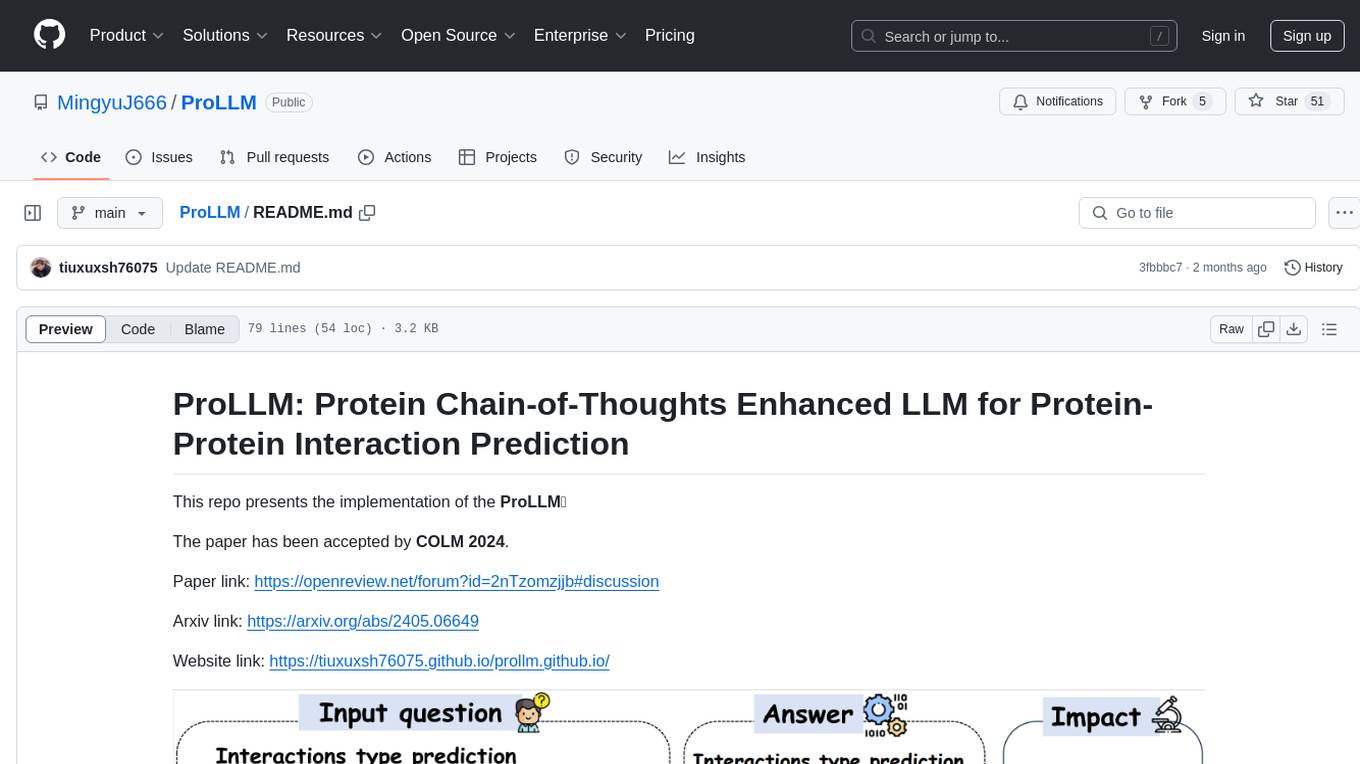
ProLLM
ProLLM is a framework that leverages Large Language Models to interpret and analyze protein sequences and interactions through natural language processing. It introduces the Protein Chain of Thought (ProCoT) method to transform complex protein interaction data into intuitive prompts, enhancing predictive accuracy by incorporating protein-specific embeddings and fine-tuning on domain-specific datasets.
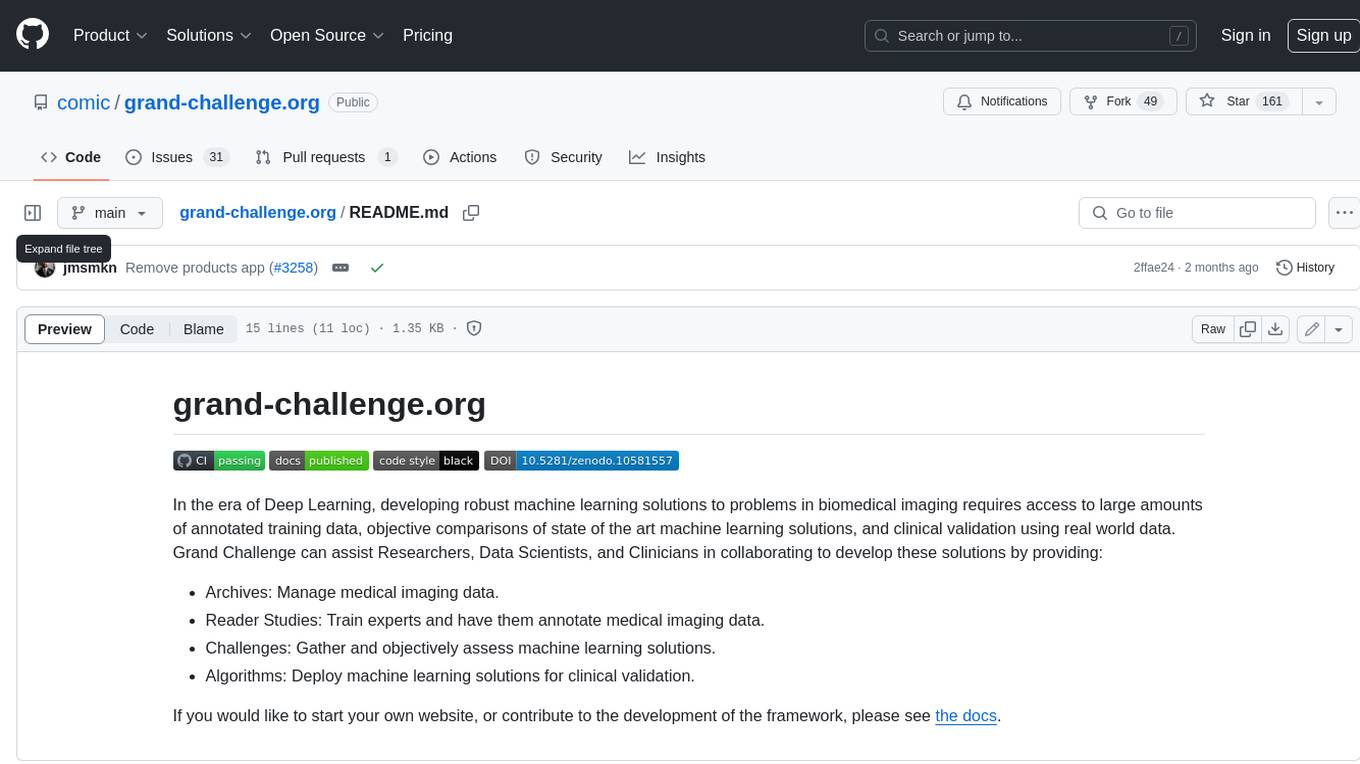
grand-challenge.org
Grand Challenge is a platform that provides access to large amounts of annotated training data, objective comparisons of state-of-the-art machine learning solutions, and clinical validation using real-world data. It assists researchers, data scientists, and clinicians in collaborating to develop robust machine learning solutions to problems in biomedical imaging.
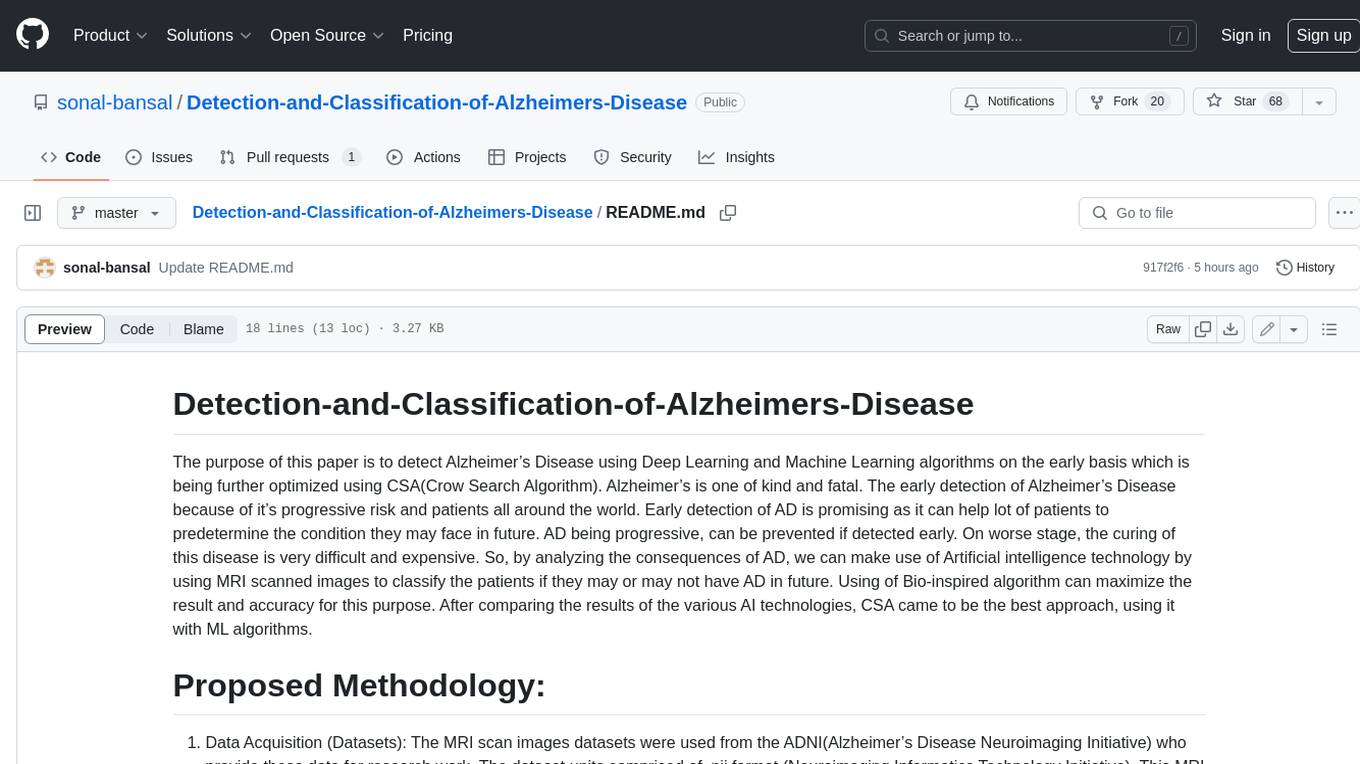
Detection-and-Classification-of-Alzheimers-Disease
This tool is designed to detect and classify Alzheimer's Disease using Deep Learning and Machine Learning algorithms on an early basis, which is further optimized using the Crow Search Algorithm (CSA). Alzheimer's is a fatal disease, and early detection is crucial for patients to predetermine their condition and prevent its progression. By analyzing MRI scanned images using Artificial Intelligence technology, this tool can classify patients who may or may not develop AD in the future. The CSA algorithm, combined with ML algorithms, has proven to be the most effective approach for this purpose.
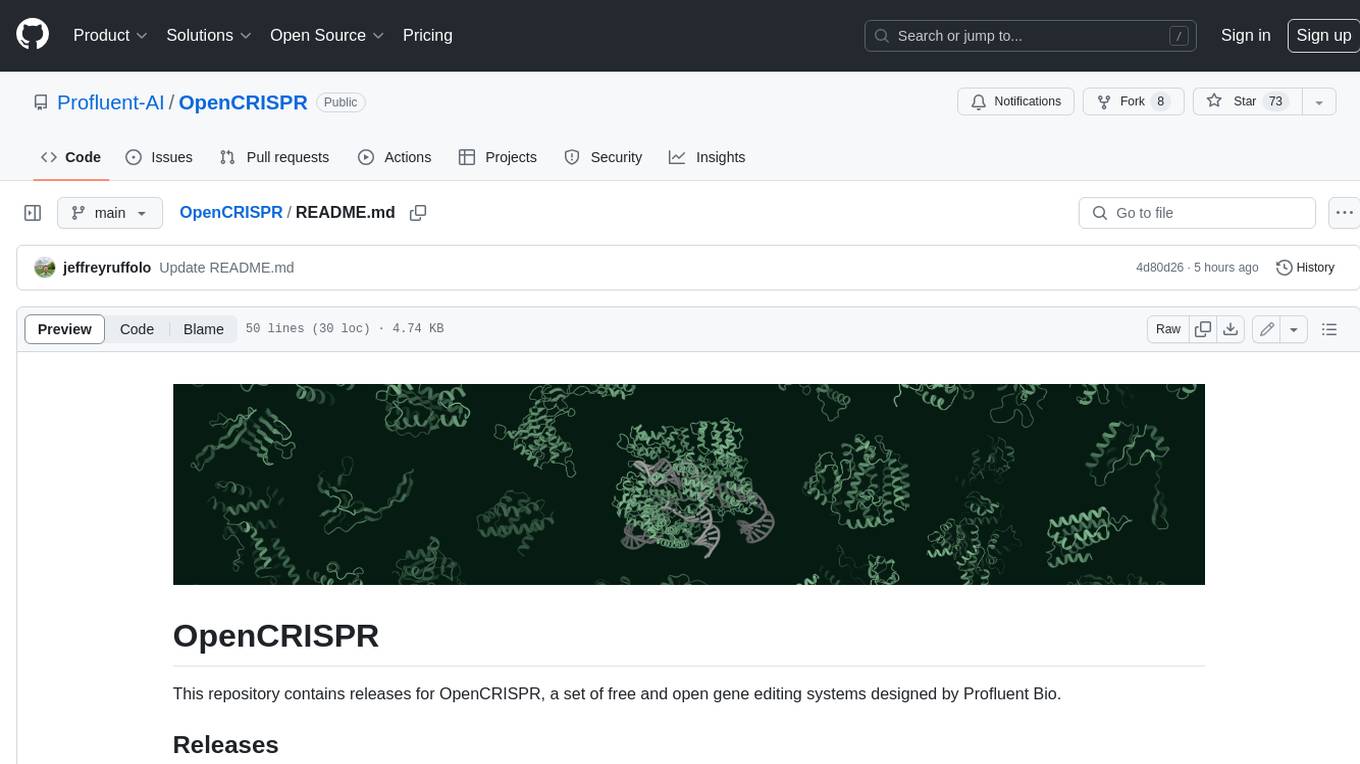
OpenCRISPR
OpenCRISPR is a set of free and open gene editing systems designed by Profluent Bio. The OpenCRISPR-1 protein maintains the prototypical architecture of a Type II Cas9 nuclease but is hundreds of mutations away from SpCas9 or any other known natural CRISPR-associated protein. You can view OpenCRISPR-1 as a drop-in replacement for many protocols that need a cas9-like protein with an NGG PAM and you can even use it with canonical SpCas9 gRNAs. OpenCRISPR-1 can be fused in a deactivated or nickase format for next generation gene editing techniques like base, prime, or epigenome editing.
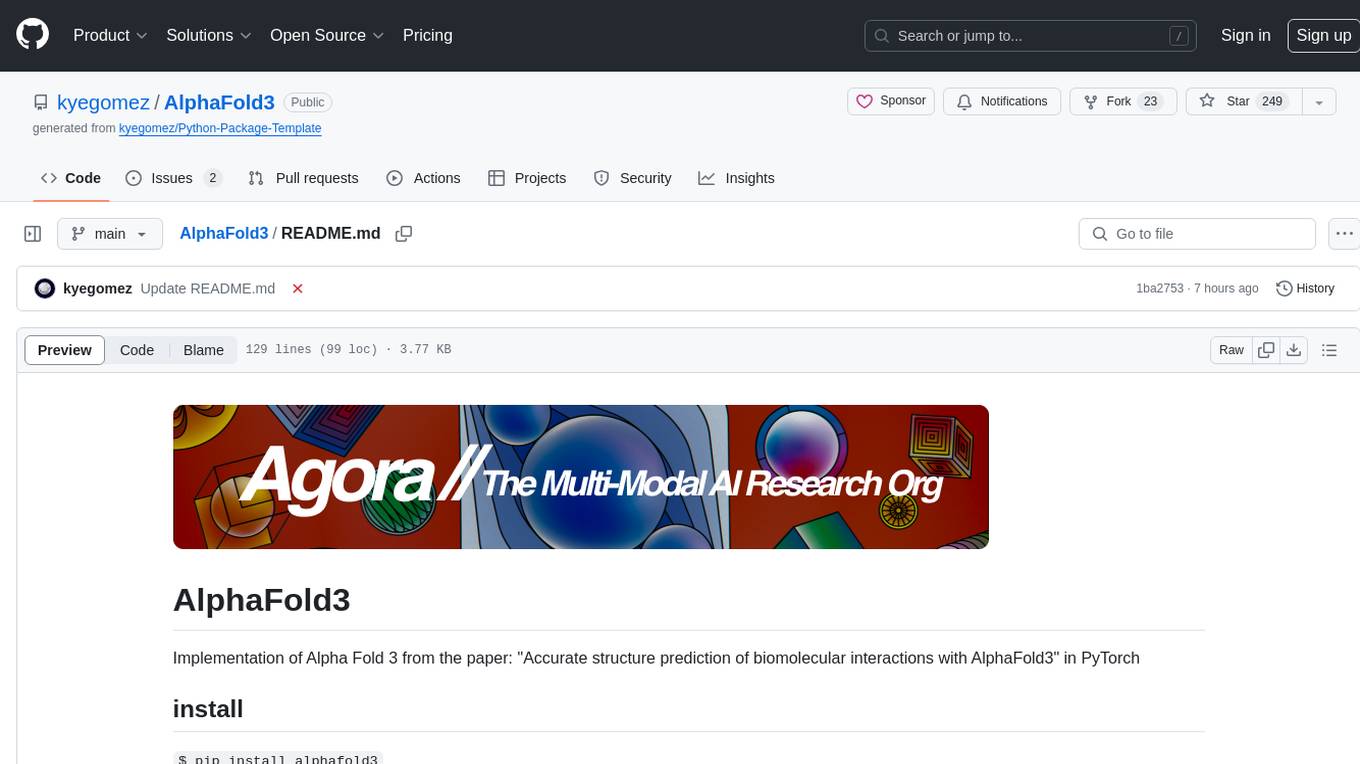
AlphaFold3
AlphaFold3 is an implementation of the Alpha Fold 3 model in PyTorch for accurate structure prediction of biomolecular interactions. It includes modules for genetic diffusion and full model examples for forward pass computations. The tool allows users to generate random pair and single representations, operate on atomic coordinates, and perform structure predictions based on input tensors. The implementation also provides functionalities for training and evaluating the model.
